LIFECYCLE
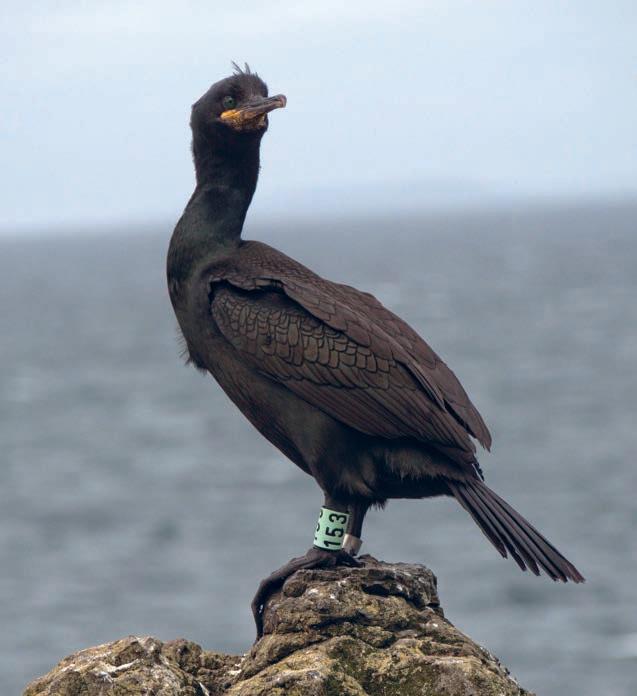
The BTO Magazine for Ringers and Nest Recorders AUTUMN 2022 ISSUE 11 BARNACLE GEESE CATCHING GULLS RINGING WOODCOCK informed by science Inspired by birds,
40 years of CES and 25 years of RAS
PROJECT RINGING Celebrating
ISSUE 11 AUTUMN 2022
Welcome to the autumn edition of LifeCycle. In this bumper edition, we bring you a summary of the NRS, CES and RAS results from the (thankfully) less Covid- impacted 2021 breeding season. This year we celebrated the 40th and 25th anniversaries of CES and RAS respectively. Our centre spread highlights some of our current projects, but we would like to extend a huge thank you to everyone who has taken part in the schemes over the past 40 years!
This edition features articles on a variety of species including Knot, Meadow Pipit, Barnacle Goose, Woodcock and gulls. There are introductions to your new RIN members and an article on how we have been using NRS and moult data to investigate Willow Warbler population trends. Thank you to everyone who has contributed to this edition. This has been another tricky year, particularly for seabird ringers, with the effects of Highly Pathogenic Avian Influenza (HPAI) being felt far and wide across Britain & Ireland. While we don’t yet know what impacts HPAI will have this winter, we would urge all ringers to be sensitive to public concerns about HPAI and to take particular care to adopt the highest hygiene standards possible while ringing.
Ruth Walker & Lee Barber
LIFECYCLE
THE BTO MAGAZINE FOR RINGERS AND NEST RECORDERS
The Ringing and Nest Record schemes are funded by a partnership of the BTO and the JNCC on behalf of the statutory nature conservation bodies (Natural England, Natural Resources Wales, NatureScot and the Department of Agriculture, Environment and Rural Affairs, Northern Ireland). Ringing is also funded by The National Parks and Wildlife Service (Ireland) and the ringers themselves. The BTO supports ringing and nest recording for scientific purposes and is licensed by the statutory nature conservation bodies to permit bird ringing and some aspects of nest recording. All activities described are undertaken with appropriate licences and following codes of conduct designed to ensure the welfare of birds and their nests is not adversely affected.
CONTACT US
The British Trust for Ornithology is a charity dedicated to researching birds. For membership details please contact: membership@bto.org
British Trust for Ornithology, The Nunnery, Thetford, Norfolk IP24 2PU Tel: (01842) 750050 Website: www.bto.org Email: ringing@bto.org, nrs@bto.org, ces@bto.org, ras@bto.org
Registered Charity no 216652 (England & Wales), no SC039193 (Scotland)
LIFECYCLE PRODUCTION
LifeCycle is the biannual magazine of the BTO Ringing and Nest Record schemes. It is freely available on the BTO website.

Articles in LifeCycle are written by ringers and nest recorders, so please send ideas and contributions to the editors:
Lee Barber – email: nrs@bto.org
Ruth Walker – email: ruth.walker@bto.org
Editors: Ruth Walker, Lee Barber, Ros Green, Justin Walker and Dave Leech.
Layout, design, imagesetting and typesetting: Ruth Walker and Mike Toms.
Printing:
Swallowtail Print, Norwich.
Copy dates:
Spring edition — 31 January
Autumn edition — 30 June
Thanks to the proofreaders for all their efforts.
Cover image: Shag, by Andrew G. Carter
The views expressed by the contributors to this magazine are not necessarily those of the Editors, the Board of the BTO or its committees. Quotations should carry a full acknowledgement. © BTO 2022
Autumn 2022 2 — LIFECYCLE
Editorial
EDITORIAL | Editorial and Contents
News from ringing & nest recording 3 Staffing changes ...................................................... 3 2021 breeding-season results ............................... 5 Connecting urban and rural birds 12 Knot: a lot of data ................................................... 14 Monitoring Meadow Pipits 16 NRS Top 100 17 Your seabirds need you ......................................... 18 Catching large gulls 20 Happy anniversaries CES & RAS ........................ 23 Wintering Blackcaps .............................................. 26 Barnacle Geese in a changing world 28 RIN: Your new-look Ringing Committee ........... 30 Into the Red 34 Working with Woodcock ....................................... 35 Eurasian African Migration Atlas ....................... 38 Moult, WILWAs and climate change 40 Developing the Nest Record Scheme ................ 42 Obituaries 43 Uphill for Pied Flycatchers 45 Publications .............................................................46 Noticeboard 47 Monitoring priorities: Dipper .............................. 48
IN THIS ISSUE . . .
NEWS FROM RINGING & NEST RECORDING
MAPPING THE UK’S FLAT FLIES PROJECT
Thank you everyone who sent flat flies for this project in 2021. Don’t forget to post any samples that you have collected. The results from 2021 are looking very interesting, although there are some gaps in geographical coverage, especially in Scotland, Wales and some of the islands, and land over 200 m. It would also be good to target flies from bird species which have not been well covered so far, including gulls, terns, waterbirds, seabirds, herons, Osprey and Nightjar. Worldwide, Osprey have their own species of flat fly, Olfersia fumipennis, which has never been recorded in the UK. Flies from Swallows are also of particular interest –so far, the project has found the 5th and 6th UK records of Ornithomya biloba!
In 2021 we discovered over 40 new bird–flat fly relationships for our region,
including about 20 bird species with no published records of being hosts to any flat flies in Britain, Ireland or the Isle of Man. Some are possibly world firsts. Early reports from 2022 suggest that there will be more new records!
I’d be delighted to receive flies and any other parasites from rare birds. I can also identify flies from Ireland and the Channel Islands but am unable to send collection kits because of the export/import regulations and there may be issues sending specimens to the UK. For more details contact Denise Wawman: denisewawman@gmail.com
SOCIAL MEDIA GUIDELINES
BTO has updated its guidance on how to get the most out of social media when communicating about your ringing and nest recording activities. The guidance, which is publicly
Saying goodbye ...
This spring we said farewell to two long-standing members of staff in the Ringing & Nest Recording Team: Jez Blackburn and Sabine Schäfer after 28 years and 14 years respectively.
Jez joined the staff back in 1994, initially on a three-month contract as a Recoveries Officer in the Ringing Team; his contract was extended several times before being made permanent. Four years later, Jez took up the role of Licensing Officer and in 2005 added supervising the sales department to his responsibilities. Before he left, Jez reflected on how much has changed since he took up his post: ‘Back in 1994 my working world was surrounded by paper. There was no internet or email and recovery processing had a delay of months, rather than today’s near-instant replies. With the numbers of ringers increasing over 50% in my time this was reflected in the volume of work; I was never short of work or bored at any stage.’
Jez isn’t giving up the ringing permit he has held for 40 years; although he is

no longer working at BTO, he will still be involved with the Scheme.
Sabine joined BTO in 2008, initially in the Terrestrial Team, working on the Thetford Forest Woodlark and Nightjar projects (as well as doing a bit of Buzzard ringing), where she proved to be a prolific nest finder. When a position became vacant in the Ringing and Nest Recording Team, Sabine joined the team as Ringing Officer. Sabine’s role included managing colourmark project registrations and renewals, as well as dealing with sightings, which resulted in her forging excellent relationships with ringers and the other ringing schemes.
Sabine has moved back to her native Germany, to an exciting new job and to be closer to her family. We wish Jez and Sabine all the best for their futures.

We are pleased to say we were successful in recruiting to the positions Jez and Sabine vacated; see overleaf for introductions to the two new members of the Team.
available, can be found at: www.bto. org/our-science/projects/ringing/ taking-part Thanks to Mike Toms for leading on this update and to Jim Lennon for his comments on the draft.
MY BTO
If you receive LifeCycle or R&M on paper, does your name and address display correctly? If not, you can update your personal information and contact preferences via the My BTO section on the BTO website. You can also change the way you receive BTO publications by clicking ‘Ringing Journals and Magazines’ under the My Subscriptions section in the left-hand menu and specifiying ‘digital’ or ‘digital and paper’. The Ringing Trainers Map and the Nest Recording Mentors Map are also both found to the bottom left of the My BTO page.
LIFECYCLE — 3 Autumn 2022
Ringing & Nest Recording | NEWS
and hello (again, in one case)
set up the fledgling Colombian Ringing Scheme, helping to organise and run ringing courses on a remote Caribbean island (San Andrés): a tough job, but someone had to do it!
MARK GRANTHAM – LICENSING OFFICER
I’m sure many of you will know me already (and I apologise for that), but for those who have somehow missed out on the pleasure ...
My very first ringing experience was rounding up moulting Canada Geese in Nottinghamshire in 1985 (or thereabouts) and it’s safe to say I was hooked, joining Attenborough RG soon after. My ringing was rather sporadic through the university years and several stints working abroad, but I really cut my teeth at Gibraltar Point Bird Observatory in Lincolnshire. After many autumns of ‘obs ringing’ (at Gib Point and Landguard), my A-permit application totals were a sight to behold!
My first job at the BTO was as a Recoveries Officer back in 2001, initially sharing a house with Dave Leech; the late night explanations of moult strategies are still fresh in my mind. My 10 years at The Nunnery evolved through Ringing Officer, Population Ecologist, BirdTrack Organiser and Research Ecologist, including celebrating 100 years of ringing in 2009. As part of this, it was inspirational to tour Britain & Ireland (as far as Cork and Orkney) talking to bird clubs and conferences about the history and continued value of ringing. The bird obs link continued and I ran numerous ringing courses at Gib Point, ably supported by Nunnery RG (aka BTO staff), but I’m not sure to this day if I enjoyed the chaos or just about survived thanks to caffeine.
This experience was useful though as, in later years, I was lucky enough to collaborate with the Wetland Trust to
Eventually I was lured to Cornwall, working remotely for BirdGuides. But I didn’t stay away for long and soon came back to the BTO (remotely) for six months of ringing database cleaning that lasted three years, the first of numerous short-term contracts back in ringing.
Now settled in the stunning southwest, I set up West Cornwall RG in 2013. The group now runs a Kittiwake RAS (and a pilot House Sparrow RAS), colour-ringing projects on Cormorant, Herring Gull, Great Black-backed Gull, Peregrine and Chough, a county-wide Barn Owl nest-box scheme (160 and counting) and also provides ringing support for various master’s and PhD projects studying urban gulls.
Outside ringing (is that even possible?), I manage a yoga-teacher partner, two dogs, four horses and (as Chair) the Board of Cornwall Birds, the county bird club. I’m also a search manager for West Cornwall Search and Rescue Team, which has had some very handy crossovers with BTO life. Why teach BTO volunteers how to navigate across Bodmin Moor at night to survey Tawny Owls when you can just teach Search and Rescue volunteers (adept at night nav) to recognise Tawny Owl sounds? Our mine rescue team have also proved extremely useful in accessing some of the more ‘interesting’ Chough sites in Cornish mine shafts and sea caves.
I’m told it’s an exciting time to be back in the BTO fold and I just need to avoid being too distracted by the colour-ringed Jackdaws, Herring Gulls and House Sparrows outside the ‘office’ window.
LOUISE BACON – RINGING OFFICER
I am a lifelong birder, having started out in the Young Ornithologists’ Club (YOC) and continuing through birding

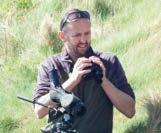
at the University of East Anglia. I have been based in Cambridgeshire since graduating as a biochemist many years ago. Jobs and careers come and go; research science as a biochemist studying the human immune system being replaced with my love of data and my hobbies of wildlife watching when I became an Environmental Records Centre data person.
I have given many years of voluntary time to the Cambridgeshire Bird Club, as research officer, atlas organiser then county recorder, before stepping down in 2021 to give myself more time to do things just for my own enjoyment. As well as birding, I have been an active nest recorder and ringer of nestlings, and still hold a ringing permit, although at present I do very little ringing.
I walked one of the original cohort of squares from the start of the Breeding Bird Survey in 1992 until 2021; however, I have three or four Upland Rover squares in northern Scotland which I usually cover using public transport and bicycle.
When it’s not birding season, it’s butterflies and moths that occupy much of my attention, regularly running a moth trap and walking a butterfly transect. I am also a conservation volunteer, actively involved in woodland management through the winter and wetland management in late summer, with the Wildlife Trust as a voluntary warden and with the Cambridge Conservation Volunteers. My favourite places to be are the Cairngorms, Argyll, the Norfolk coast or northwest Spain.
Autumn 2022 4 — LIFECYCLE NEWS | Ringing & Nest Recording
...
A welcome return to normality
With memories of Covid-19 restrictions fresh in the mind, the ability to access ringing and nest-recording sites could only improve in 2021. Thankfully, that proved to be the case, with the majority of volunteers able to resume normal activities last year. In this article, we interpret the results from CES, RAS and NRS to bring you the highs and lows from the 2021 breeding season.
The number of nest records submitted for the 2021 season was 40,865, slightly more than the totals received in 2019, pre-pandemic. The number of CES and RAS projects that operated in 2021 also more-or-less returned to pre-pandemic levels, with 104 CES projects and 195 RAS projects running. Additionally, data were submitted from 57 Garden CES sites, although the results from that trial project are not included here. Data for 65% of CES sites, 64% of RAS projects and 67% of NRS records were entered via DemOn in 2021. We are extremely grateful for the continued support for CES, RAS and NRS, and for all the time and effort ringers and nest recorders put into these schemes.
The lack of nest records from early 2020, a result of Covid lockdowns at the start of the breeding season, has led to a temporal bias which might affect results. The 2021 NRS results have therefore been compared to a mean spanning four years (2016–19) rather than the usual five. The data for 2020 will still be used in other analyses that are able to account for this bias.
Winter 2020/21 was colder and wetter than average and the cold weather
continued into the breeding season, with April 2021 being the coldest since 1989 and May 2021 the coldest since 1996. March and April were drier than average but May was far wetter than normal. The weather in summer was variable, with Scotland seeing high temperatures with reduced rainfall, while south-east England was far cooler and wetter than average; Wales, Northern Ireland and northern England were also drier than average. July 2021 proved to be the equal fifth warmest July since 1884 and included an all-time record high temperature in Northern Ireland of 31.3°C.
MIGRANT PASSERINES

Migrant abundance and survival
Of the eight migratory species monitored through CES, four exhibited significant increases in abundance in 2021 compared to the five-year mean (2016–20; Table 1).
Whitethroat recorded the largest increase (35%), followed by Sedge Warbler (24%), with smaller increases for Chiffchaff (14%) and Reed Warbler (7%). The increases for Whitethroat and Chiffchaff appear to have been driven by results in the East and West, where numbers seem to have
LIFECYCLE — 5 Autumn 2022
Swallow and Sand Martin were the only two migrant species to record significant increases in the number of fledglings per breeding attempt in 2021.
2021 breeding season | ANNUAL RESULTS
Swallow, by Edmund Fellowes/BTO
Table 1. National and regional CES results for 2021. For long-term trends, indicates an increase of <25%, of 25–50% and of >50%, while indicates a decrease of <25%, of 25–50% and of >50%. Percentage changes from the five-year means (2016–20) are also reported for 2021, with significant decreases shown in red and significant increases in blue. ‘*’ denotes a small sample size. Sample sizes are currently not large enough to allow regional survival trends to be produced. See CES website for map of regions. 1985–2021 2021 vs 2016–20
been particularly high in 2021. None of these species had significantly productive breeding seasons in 2020, and none recorded significant increases in overwinter survival between 2020 and 2021. It is possible that the increases are due to high levels of recruitment of those juveniles that did fledge in 2020, but this is a difficult aspect of life history to measure due to the high levels of dispersal and lack of natal site fidelity in young birds of these species.
The only migratory species to record a significant decrease in numbers nationally
in 2021 was Willow Warbler (-10%), a decline which appears to have been driven by results in the North. As with the species that increased in abundance in 2021, Willow Warbler productivity in 2020 was not significantly increased or decreased and it did not record a significant decline in overwinter survival. The decline in abundance is therefore likely to be a result of poor juvenile recruitment.
The short-distance migrants Chiffchaff and Blackcap remain the only migratory species to show long-term (1983–2021)
Autumn 2022 6 — LIFECYCLE ANNUAL RESULTS | 2021 breeding season Chiffchaff 14 -5 14 32 15 -22 23 -32 -29 Willow Warbler -10 -20 -4 8 -9 -24 -4 -35 -35 Blackcap -5 -19 -3 -2 -1 -44 -37 -48 -38 Garden Warbler -2 -39 6 6 0 -35 48 -43 -36 Lesser Whitethroat* -2 -24 9 -44 -22 -23 -80 -33 69 Whitethroat 35 -8 34 68 31 -42 27 -47 -41 Sedge Warbler 24 16 40 18 10 -34 19 -57 -4 Reed Warbler 7 10 11 -6 -5 -21 29 -29 -8 Tits Blue Tit 7 13 7 -1 10 -23 -21 -24 -20 Great Tit 4 7 -2 17 -1 -40 -48 -35 -44 Willow Tit* -28 27 - - -42 -57 -Long-tailed Tit 4 4 7 -4 -30 -32 -32 -31 -32 Other residents Cetti’s Warbler* 33 58 35 8 - 20 -21 2 Treecreeper* 20 96 -13 32 - -46 -53 -41 -39 Wren 17 24 15 14 21 -32 -26 -36 -30 Blackbird -8 1 -13 3 21 -36 -62 -30 -40 Song Thrush -1 5 -8 17 -53 -24 -12 -43 -5 Robin 4 8 1 4 24 -16 -20 -14 -14 Dunnock 10 0 13 18 22 -35 -45 -37 -23 Chaffinch -39 -30 -50 -25 -64 14 -17 -21 -4 Bullfinch -11 8 -39 6 -1 -18 -25 -36 14 Greenfinch -35 -21 -45 - 1 -12 41 Goldfinch -1 8 1 -10 - -53 -70 -43 -65 Reed Bunting -8 -1 -13 -15 28 17 -52 -45 99
1985–2021
1985–2021 2021 vs 2016–20 ADULT ABUNDANCE PRODUCTIVITY ADULT SURVIVAL ↑ ↑ ↑↑↑ ↑↑↑ ↑↑↑ ↑↑ ↑↑ ↑↑ ↑↑ ↑↑ ↑↑ ↑↑ ↑↑ ↑ ↑ ↓ ↓↓ ↑ ↑ ↓ ↓ ↓ ↓ ↓ ↓ ↓ ↓ ↓ ↓ ↓↓ ↓↓ ↓↓ ↓↓ ↑↑↑ ↓↓ ↓↓ ↓↓ ↓↓↓ ↓↓↓ ↓↓↓ ↓↓↓ ↓↓↓ ↑↑↑ ↑↑↑ ↑↑↑ ↑↑↑ ↑↑↑ ↑↑↑ ↑↑↑ ↑ ↑ ↑ ↑ ↑ ↑ ↑ ↑ ↑ ↑ ↑ ↑ -National North East West National North East West Migrants ↑ ↑ ↓ ↑↑↑ ↓ ↑↑ ↓↓↓ ↑ ↑↑ ↑ ↑↑ ↓ ↓↓↓---
2021 vs 2016–20
increases in abundance, with the other species all declining by between 22% (Reed Warbler) and 91% (Willow Warbler) over the same time period.
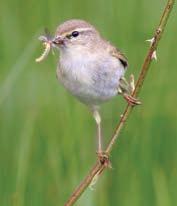
As is often the case, the apparent survival rates for the migrant species monitored through RAS varied in 2021. House Martin survival declined for the third consecutive year while Swallow recorded a slight decline after a couple of years of positive results. By contrast, Sand Martin recorded a small increase in survival. The long-term trends for all three species show fluctuations in the survival rate every two or three years and none of these results conflict with this regular pattern. Declines in survival were also seen for Pied Flycatcher, Wheatear and Wood Warbler, although the large confidence intervals around the mean for the latter suggests this result should be viewed with caution. The long-term trends for all remain stable. More positively, Nightingale and Whinchat recorded increases in 2021 and the long-term trends for both also show slight increases. The survival rate for Tree Pipit showed no change from 2020.
Migrant productivity
Results from NRS show that most migrant species bred significantly later in 2021 than the mean (2016–19; Table 2). Swallow and Sand Martin laying dates were 6.8 days and 5.8 days later respectively, with Pied Flycatcher laying 5.2 days later than average. Redstart, Willow Warbler and Reed Warbler all laid three to four days later than the mean. It is likely that the unseasonably cold weather at the start of the breeding season contributed to these delays. Despite the late start, Sand Martin and Swallow had a good breeding season, with both recording significantly increased numbers of fledglings per breeding attempt (FPBA). None of the other migrants monitored by NRS recorded significant changes in FPBA.
2021 was a dismal breeding season across the board for migrant species monitored through CES, with all but Lesser Whitethroat recording a significant decline in productivity of between -21% and -44% from the five-year mean (2016–20; Table 1). Of the eight migrant species monitored, productivity was lowest for Blackcap,
which declined significantly across all regions, whereas the declines for the other species were driven by results in the East and West, with birds in the North faring less badly. For those species where higherthan-normal abundance was recorded in 2021, the increase in the number of individuals present could have led to increased competition for resources, which may in turn have been the driver of lower productivity.
RESIDENT SPECIES
Resident abundance and survival
There were mixed fortunes for the resident species monitored through CES in 2021, with three increasing significantly compared to the five-year mean (2016–20, Table 1) and three decreasing significantly, with the other species not recording significant changes. The largest increase in numbers was recorded for Cetti’s Warbler (33%), followed by Wren (17%) and Dunnock (10%). Of these, only Dunnock recorded a significant change in productivity in 2020, a 19% decline. Although neither Wren nor Dunnock recorded a significant increase in overwinter survival between 2020 and 2021, survival rates were the highest for Dunnock since recording began in 1983; sample sizes are too small to produce a survival estimate for Cetti’s Warbler. The increase in Dunnock numbers is therefore likely to be a result of high overwinter adult survival, possibly helped by reduced
Further results from the 2021 season will be available in due course on the BirdTrends website: www.bto.org/ birdtrends
The full suite of RAS results from 2021 can be found at: www.bto.org/ ras-results
LIFECYCLE — 7 Autumn 2022 2021 breeding season | ANNUAL RESULTS
Willow Warbler, by Edmund Fellowes/BTO
Table 2. Laying dates and breeding success calculated from 2021 NRS data. Laying dates are given as the number of days earlier or later than the mean (2016–19); productivity figures represent a percentage change relative to the mean. Statistically significant ‘positive’ and ‘negative’ changes are highlighted in blue and red respectively. ‘*’ denotes small sample size (<25 records).
Autumn 2022 8 — LIFECYCLE ANNUAL RESULTS | 2021 breeding season Species Laying Clutch size Brood size Egg-stage Chick-stage Fledglings date (days) (%) (%) survival (%) survival (%) produced (%) Migrants Sand Martin 5.8 -1.7 8.3 -0.8 1.5 9.0 Swallow 6.8 -0.1 0.4 2.1 6.5 9.1 Chiffchaff -1.8 0.6 2.3 1.4 -3.9 -0.3 Willow Warbler 3.4 8.1 2.2 -10.6 -8.9 -16.8 Blackcap -2.1 -4.1 -6.3 -13.4 -11.1 -27.9 Reed Warbler 3.8 -2.5 -5.1 4.7 -4.2 -4.9 Spotted Flycatcher 3.4* 4.4 -2.6 -6.9 3.7 -6.0 Pied Flycatcher 5.2 -5.1 -5.1 -3.5 6.7 -2.3 Redstart 4.0 -3.8 -1.8 -2.2 11.5 7.1 Tits Blue Tit 1.4 -2.9 -5.0 -2.0 -5.1 -11.7 Great Tit 2.8 -6.7 -11.8 -3.6 -5.5 -19.7 Long-tailed Tit -1.1 1.0 4.8 -0.9 -7.0 -3.4 Other resident passerines Jackdaw -0.6 3.4 -3.4 -0.3 -1.0 -4.6 Nuthatch 1.7 -0.9 -6.5 -4.6 -8.8 -18.7 Wren 5.0 -1.8 -0.9 -8.2 -1.7 -10.6 Starling 2.3 2.6 -2.8 -2.1 -7.8 -12.3 Dipper 3.7 0.1 4.6 -0.1 3.7 8.4 Blackbird -0.9 -0.8 1.3 -5.4 -8.6 -12.4 Song Thrush 1.9 -2.8 -5.5 -9.0 -11.3 -23.7 Robin 2.4 -2.1 -0.9 -1.7 -14.7 -17.0 Stonechat -6.7 -0.2 3.6 -1.7 -14.4 -12.8 Dunnock 1.2 -2.1 -4.7 -5.4 -16.7 -24.9 House Sparrow -2.6 -2.5 -7.7 -2.0 -0.8 -10.3 Tree Sparrow -0.0 -3.6 -7.2 -5.1 -1.6 -13.3 Grey Wagtail -5.1 -4.6 -1.1 2.7 -7.4 -5.9 Pied Wagtail 2.5 -1.7 -2.6 1.1 -3.2 -4.7 Chaffinch 6.3 -4.0 -6.5 -0.6 -12.5 -18.7 Linnet -2.7 -0.1 0.5 8.2 -2.3 6.2 Resident non-passerines Stock Dove 1.1 -4.1 -0.7 -4.2 8.2 3.0 Woodpigeon 3.1 2.1 0.9 -7.6 -11.8 -17.7 Owls
Barn Owl 12.2 -2.0 -3.4 -4.1 0.1 -7.5 Little Owl 3.8* 13.9 0.9 5.1* -2.8 3.0 Tawny Owl 8.8* 0.7 -1.0 -9.5 -0.1 -10.4 Kestrel 6.0 -3.2 1.3 3.0 2.5 6.9 Waterbirds Moorhen -3.4 0.1 11.1 -15.7 17.5* 10.0 Coot -5.1 6.4 2.5 -5.5 -45.1* -46.9
and raptors
competition for resources as a result of there being fewer juvenile birds in the population. The long-term trend for Cetti’s Warbler shows a continuous increase in numbers for this species, reflecting their rapid colonisation of England and Wales since the first breeding record in Kent in 1973. The increase in Wren numbers may have been a result of high juvenile overwinter survival. Although not exhibiting a significant increase in abundance in 2021, Treecreeper was recorded in greater numbers than in any previous CES year.
The three species that exhibited declines in abundance were Chaffinch (-39%), Bullfinch (-11%) and Greenfinch (-35%). For Chaffinch and Greenfinch, numbers recorded in 2021 were the lowest on record. Nine of the worst seasons for Chaffinch abundance have occurred in the past 10 years, while the past five years have been the worst on record for Greenfinch, with each new season being progressively worse. Bullfinch is the only one of the three to record a significant decline in productivity in 2020, suggesting poor juvenile recruitment may have led to the reduced numbers caught on CE sites in 2021. Chaffinch recorded a significant decline in adult overwinter survival between 2020 and 2021; however, Greenfinch recorded neither reduced productivity in 2020 nor reduced overwinter adult survival, suggesting the mechanism for its decline might have been poor recruitment caused by high levels of juvenile mortality. Song Thrush was the only other species to record a significant change (-53%) in adult overwinter survival.
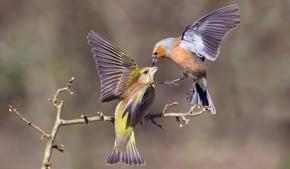
The apparent survival rates for the resident species monitored through RAS were nearly all positive in 2021, with only Linnet recording a small decline, although the long-term trend still shows a slight increase. Results from two new Starling projects and single new Hawfinch, House Sparrow and Jackdaw projects were added to the analyses in 2021. House Sparrow and Starling remain the two resident species with data from the highest numbers of current and historical projects contributing to the trends (18 and 16 respectively); across RAS species, only Pied Flycatcher and Sand Martin have more projects contributing to their trends (29 and 23 respectively).
The survival rate for Bearded Tit increased sharply in 2021, with the trend now at its highest point in the series. House Sparrow recorded a shallow increase for the third consecutive season, maintaining the long-term increase in survival rate for this species. Starling is another species whose long-term trend is increasing; after a couple of seasons of small declines, 2021 was a better year for this species and it recorded a small increase. Jackdaw recorded an increase in survival for the second consecutive year, although the long-term trend is stable. Dipper, Stonechat and Siskin are all species for which long-term trends fluctuate, often annually. After exhibiting declines in 2020, the survival rates for all three species increased in 2021, maintaining relatively stable trends over the long term. Although the projects ran in 2021, the RAS analysis programs struggled to calculate accurate survival rates for Hawfinch and Twite.
Resident productivity
Data from both NRS and CES indicate that 2021 was a dreadful year for Blue and Great Tits compared with the mean. NRS results show that both species delayed the start of the breeding season, recorded significantly reduced clutch sizes, brood sizes, egg- and young-stage survival as well as exhibiting reduced FPBA. For Great Tit, FPBA and brood-size figures were the lowest on record in 2021. CES figures show significant reductions in productivity of -23% for Blue Tit and -40% for Great Tit. It is likely that the very cold weather in April reduced the availability of the caterpillars these species
LIFECYCLE — 9 Autumn 2022 2021 breeding season | ANNUAL RESULTS
Greenfinch and Chaffinch, by Edmund Fellowes/BTO
RAS survival trends. Survival is measured from the year indicated on the graph to the following year: i.e. the figure for 2020 is the survival rate from 2020 to 2021. The dotted lines show the upper and lower 95% confidence limits about the modelled estimate.
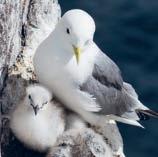

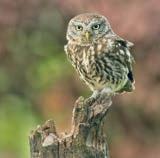
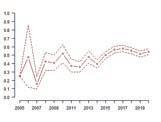
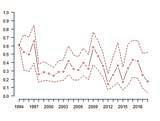
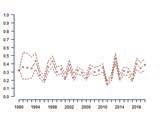

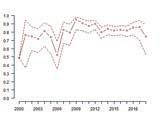

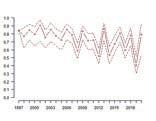
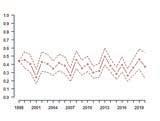
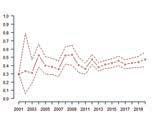
Autumn 2022 10 — LIFECYCLE ANNUAL RESULTS | 2021 breeding season
House Martin
Starling
Barn Owl
Little Owl
House Sparrow
Kittiwake
Jackdaw Swallow
Sand Martin
Kittiwakes, by Philip Croft/BTO; Starling by Sarah Kelman/ BTO; Little Owl, by Edmund Fellowes/BTO
need to feed their young, resulting in the poor breeding success seen last year.
The other resident species to record significant changes in laying dates were Dipper and Wren, both of which laid late, and Stonechat which laid significantly earlier than normal. Dipper is a particularly early breeder, so it is again possible that the cold spell in early spring caused this species to breed later than normal. Stonechat, which recorded its earliest ever first-egg date, is a double-brooded species so, if fewer second broods were recorded in 2021, this could have advanced the mean laying date for this species. Only one other species recorded a significant change in FPBA in 2021 compared with the mean. Tree Sparrow had significantly reduced clutch size, brood size and egg-stage survival, resulting in fewer fledglings per breeding attempt.
OWLS AND RAPTORS
After a poor season in 2020, the apparent survival rate for Barn Owl in 2021 bounced back to levels similar to those seen in 2019. Over recent years, Barn Owl survival rates have fluctuated on an annual basis, although the long-term trend still shows a decline. The survival rate for Little Owl declined in 2021. This species also exhibits a longterm decline; however, as this trend is generated from a single project (compared to four projects for Barn Owl), it is less likely to reflect the picture at a national level. Although the Tawny Owl project did operate in 2021, the data weren’t received in time to be included in the analyses.
Results from NRS indicate that it was a late start to the breeding season for both Barn Owl and Kestrel, with these species laying 12.2 and 6 days later than their respective means. Neither they, nor Little Owl or Tawny Owl recorded any significant changes in FPBA, however, suggesting the late start did not affect their productivity. The delayed breeding season may have been caused by a reduction in food availability as a result of the particularly cold spell of weather in early spring.
SEABIRDS AND WATERBIRDS
After being particularly badly impacted by Covid-19 restrictions in 2020, most
seabird RAS projects were able to operate normally in 2021. Trends were produced for 11 seabirds, including Common Tern, for which a trend was produced for the first time, and one sea duck (Eider).
The two terns monitored (at the same site) for RAS, Arctic and Common, recorded opposite fortunes in 2021, with Arctic Tern declining and Common Tern increasing. The increase in the apparent survival rate for the latter is welcome as it follows a period of continued decline. There were mixed fortunes for the gulls monitored through RAS. Both the Great Black-backed Gull and Herring Gull trends show increases in survival in 2021 while Kittiwake and Lesser Black-backed Gull recorded declines. The long-term trend for Kittiwake is positive, although the survival trend between colonies varies greatly. The trends for Great and Lesser Black-backed Gulls in contrast are negative; the trend for Herring Gull is stable.
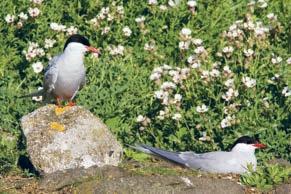
Results suggest that 2021 was not a good year for Guillemot and Razorbill, with both recording declines in the survival rate. The results for Puffin were more positive, albeit the recorded increase was only slight. The results for Shag and Storm Petrel were not reliable due to the large confidence intervals around the mean.
NRS trends are produced for both Moorhen and Coot; however, neither exhibited any statistically significant changes in any parameter monitored through NRS in 2021.
The detail in this report highlights the tremendous effort by nest recorders and ringers to collect these data, monitoring changes in the fortunes of bird populations over time and, vitally, identifying the causes. As ever, we’d be very pleased to hear from anyone wanting to participate in future; email ces@bto.org, ras@bto.org or nrs@bto.org for more information.
LIFECYCLE — 11 Autumn 2022 2021 breeding season | ANNUAL RESULTS
Arctic Terns, by Edmund Fellowes/BTO
Connecting urban and rural birds
Despite many ringers ringing in and near urban areas, little is known about the direction or extent of urban–rural movements of garden birds. In this article, Research Ecologist and bird ringer Hugh Hanmer discusses the results of a BTO pilot study seeking to understand the links between our urban and rural bird populations.
Urbanisation has huge consequences for our birds; although many of these are negative, gardens and urban areas more generally support large populations of some species. This is in large part due to the opportunities we create, such as providing bird food and nest boxes. As recent research shows, the influences of aspects of urbanisation, such as bird feeding, potentially extend out into the countryside (Shutt et al. 2021); yet how bird populations in urban areas are linked to those in the surrounding countryside is poorly understood. Does one habitat act as a source and the other a sink (i.e. do birds moving from one habitat sustain the population in another), do birds move largely freely between the two in one big population or do they act as broadly separate populations with limited interchange?
As most birds are territorial during the breeding season and so do not move around, such links are likely to be seasonal. We might expect for example, that birds will move into gardens in the winter to take advantage of bird feeders
before moving (back) out into the countryside to breed, or alternatively, birds wintering in the countryside could move into gardens in the spring to take advantage of nest boxes to breed in.
Understanding these linking movements has important implications for disease transmission and gene flow, as well as the overall importance of urban bird populations at a regional and national scale. Movement studies of this nature often use radio or GPS tracking, which, while potentially yielding highly detailed data, is limited in sample size and practicality due to technological limitations and associated costs, especially with small bird species. Instead, we set out to develop a relatively low-cost proof of concept study to investigate this issue, using a combination of bird ringing and resighting surveys in and around Birmingham in 2017–19.
RINGING AND SURVEYS
Blue Tits and Great Tits were colour ringed at woodland/scrub and urban/ suburban garden ringing sites with

feeding stations on either side of the rural–urban boundary during the winters of 2018/19 and 2019/20. These species were chosen because they are abundant at winter feeding stations, breed in both urban and adjacent rural areas in large numbers, and are sedentary and territorial during most of the breeding season. Due to the potential numbers involved, rather than individual combinations, birds were marked with a single site-specific colour ring. The ringing sites were laid out along transects, each with one or two rural sites and two to four gardens 400–1,500 m apart, extending from the countryside into three suburbs of Birmingham. In the following breeding season, around each of the ringing sites, a professional BTO surveyor carried out surveys to identify potential breeding territories, and followed up with dedicated resighting surveys to identify ringed birds.
RESULTS
Across the sites and winters some 540 Blue Tits and 320 Great Tits were
Autumn 2022 12 — LIFECYCLE RESEARCH | Garden bird movements
Blue Tits and many other species have large urban populations but how they are linked to wider populations in the countryside is poorly understood.
Blue Tit, by Philip Croft/BTO
ringed, with 61 Blue Tits and 44 Great Tits subsequently being resighted. Aside from one rogue Blue Tit that travelled 28 km from one side of Birmingham to the other, the average (median) movement distances for both species between the winter and breeding season were similar, with garden birds moving significantly less on average (40 m, i.e. effectively zero, for both species) than rural birds (210 m for Blue Tit and 300 m for Great Tit). We also found that rural birds not only moved further but, from comparing the local level of urbanisation around individuals’ winter ringing sites and subsequent breeding territories, were also more likely to move to more urban locations, with 46% of Blue Tits and 80% of Great Tits from rural sites moving to more urban sites, compared to only 14% and 7% of garden birds moving to more rural locations.
DISCUSSION AND FUTURE DEVELOPMENTS
Overall, these results suggest that rural wintering birds tend to move more between seasons and that, while urban
and rural populations are connected, urban areas may act as a sink for rural wintering birds, supplementing the resident urban population. This is arguably the opposite to what we might have expected, with rural birds more often moving into gardens in the winter than the converse.
The study has demonstrated the feasibility of this approach and has now been published in Bird Study (Hanmer et al. 2022), but only covered one city and short movement distances. It would be valuable to look further along transects into the countryside and into urban areas, alongside considering different sizes of settlement from hamlets and villages up to towns and cities. It would also be useful to consider potential barriers such as major roads and corridors for movement such as rivers lined with trees. What about other species – do other common birds behave similarly to the two tit species we included in this pilot study?
It may also be interesting to see whether the movements of first-winter and older birds differ, using age cohort
rings. Although achieving sufficient sample sizes would be challenging, it would also be valuable to understand natal dispersal from the nest, i.e. the movements and behaviour of birds hatched in adjacent rural versus urban areas.
Lots of questions remain, but this project provides a proof of concept for exploring how different populations of birds are connected at a local level. In particular, follow-on studies could help to reveal the true importance of urban and garden habitats for common bird populations.
We are considering developing this study further as part of BTO’s Urban Appeal (www.bto.org/urban-appeal), so look out for more research into this area and opportunities to take part in the future, most likely from winter 2023/24. If you’d like to register your interest in this planned research at this very early stage please email hugh.
hanmer@bto.org
THANK YOU
Thank you to ringers Rob Skeates, Ross Johns and Andy Spencer, fieldworker Steve Davies for carrying out the bird surveys, and the garden owners (most of whom were BTO Garden BirdWatch volunteers) and landowners for facilitating access. This work was generously funded by a legacy gift from Jane Priest along with grants from the Edward Cadbury Charitable Trust, the Marjorie Coote Animal Charity Trust and the John Spedan Lewis Foundation.
REFERENCES
Shutt et al. (2021) Faecal metabarcoding reveals pervasive long-distance impacts of garden bird feeding. Proceedings of the Royal Society B 288, 20210480
Hanmer et al. (2022) Evidence that rural wintering populations supplement suburban breeding populations. Bird Study, doi: 10.1080/00063657.2022.2139814
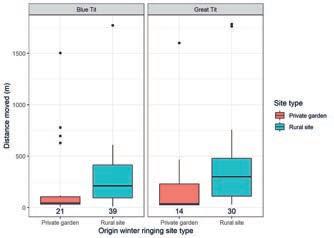
LIFECYCLE — 13 Autumn 2022 Garden bird movements | RESEARCH
Distances moved by colour-ringed Blue Tits and Great Tits between winter ringing sites and breeding-season territories. The numbers below the boxplots are the number of birds subsequently resighted.
Knot: a lot of data
Much of what is known about Knot in Britain & Ireland comes from a few large catches taken here and in Iceland in the 1960s and 1970s. These valuable data showed that islandica Knot arrive here from the Arctic in summer, moult and then many disperse in late autumn. In spring, many adult Knot head eastwards to the Wadden Sea, and then stage in Iceland or Norway before continuing to their Nearctic breeding grounds. Richard du Feu, Rose Maciewicz and Peter Knight present a more recent study on Knot in the northwest of England.
The excellent Wetland Birds Survey (WeBS) provides good information on the timing of Knot movements and confirms that they continue to behave as indicated from historical ringing records. What WeBS cannot detect are sites with both emigration and immigration at the same time, as occurs around the estuaries of the west coast. Large-scale colour-ringing projects run by the Royal Netherlands Institute for Sea Research (NIOZ) around the Wadden Sea, and Jim Wilson’s work in Iceland and Norway, provide some insight into individual bird behaviour and timing of migration. Relying on birds marked elsewhere to infer what is going on at a specific site is a good start, but has significant limitations because it is looking at only a subset of individuals.
In 2017, a Knot colour-ringing project was started as a collaboration between several groups of ring readers, ringers and the MOD on the Alt Estuary just north of Liverpool. In the winter of 2017/18, 1,015 birds were individually marked. Sightings rapidly came in locally and, as spring 2018 began, internationally. In May 2018 around 10% of the birds marked on the Alt were
found in Iceland. As the autumn migration season began, sightings arrived from wellknown, and some less well-known, Knot hotspots such as the Wadden Sea, The Wash, Staffordshire and the Azores.

Our data (c. 13,000 sightings) have shown that the re-encounter probability of a colour-marked Knot is at least 100 times greater than Knot marked with metal only. This gives a much higher resolution of data and is only possible thanks to tremendous observer effort in the northwest. Achieving this level of re-encounter information from conventional ringing would be impractical and undesirable, due to the special tidal conditions needed to catch Knot and the additional disturbance pressure that catching would create.
While the movement records give insight into how birds wintering on the west coast of Britain are much more likely to stage in Iceland than Norway, many questions remain both on a local and international scale. Year-round intensive observation in the northwest has shown that subpopulations of Knot use the area at different times of the year. Locally, birds regularly move 20 km or more between
Autumn 2022 14 — LIFECYCLE
Colour-marked Knot ‘M8’, helpfully on the edge of a dense flock of roosting birds.
FIELDWORK | Knot
Knot flock, by Howard Stockdale/BTO
feeding and safe roosting sites depending on tide state. Others have made multiple trips between the Alt Estuary and Morecambe Bay within a winter. These movements can be interpreted in many ways, but really highlight the importance of having multiple safe feeding and roosting sites across a wide multi-estuary area, to ensure enough habitat is available.
In 2018, news broke of a terrible breeding season for Sanderling around Zackenberg in Greenland, as a result of unusual weather conditions. This was rapidly exaggerated by social media into a total failure of breeding in the Arctic for waders. At the same time as this was getting a lot of interest, the Knot were arriving back in the northwest and, with intensive reading of colour rings, the arrival dates of individuals were revealed. The wing lengths taken at ringing sessions showed that longer-winged birds, which are more likely to be females, were arriving back earlier, with later-arriving birds having shorter wings and therefore more likely to be males.
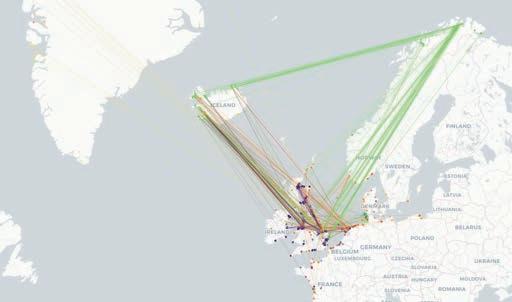
As male Knot do most of the chick care and females leave shortly after eggs hatch, this implied that Knot had at least produced chicks. This conclusion was confirmed by WeBS counts the following summer that showed good numbers of second-calendaryear birds were indeed present.
Second-year Knot rarely migrate north, and the northwest UK has long been known as one of the few summering and moulting areas for them; historically, however, few second-year Knot had been caught during this key period. May 2021 provided a good chance to change this, with large numbers of second-year Knot assembling on the beach at Ainsdale. A total of 250 secondyear birds were colour marked along with a sample of 50 adults. Most of these secondyear birds stayed for the summer, then dispersed after moulting with just a few staying for the winter around the Alt and Dee estuaries; many were subsequently seen in Dublin Bay over winter. It will be very interesting to discover where these young birds are seen in the coming years.
THANKS
We thank the members of the ringing groups that have undertaken the catches, the staff at MoD Altcar Training Camp and Green Sefton for their great assistance in the success of our catches, and the many observers who are providing sightings of our colourmarked birds.

LIFECYCLE — 15 Autumn 2022 Knot | FIELDWORK
Seasonal movements of Knot, to and from the northwest of England. Map from Franks, S. et al. (2022) Online Atlas of the movements of European bird populations. https://migrationatlas.org EURING/CMS
Monitoring Meadow Pipits
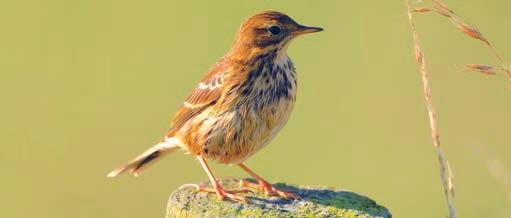
Tom Dewdney has caught small numbers of Meadow Pipits in a variety of locations and at different times of the year but, until recently, had never managed to catch them in good numbers and with such little effort. In this article, Tom explains the technique he now uses to catch and how he still finds that exciting!
Meadow Pipits in the northeast of England usually breed on the higher moorland areas in the Pennines and on the North Yorkshire Moors but they can be found on lower ground in the valleys and around the coast, particularly in the early autumn before many of them move south-west towards maritime France or Spain, and on their return in the spring. Meadow Pipits are probably the most numerous species found breeding on the uplands during the summer.
numbers; once a lure is played, they appear as if from nowhere. In the late summer, I have chosen netting sites on hill farms where the fields comprise rough grass and patches of stronger plants like Juncus and are edged by stone walls.
REFERENCE
Jenni, L. & Winkler, R. (1994) Moult and Ageing of European Passerines Academic Press, London.
Over the years I have netted pipits in a variety of locations and using a variety of techniques, including the famous triangle of nets with a sound lure in the centre. I have found that Meadow Pipits respond well to sound recordings of both their call and song. Initially, I used these sounds to attract birds on my lowland farm locations in both the spring and the autumn and latterly I have found that this technique is even more successful in the months of July to early October in the uplands.
Apart from during the breeding season, Meadow Pipits are very quiet and I have found that just looking and listening for this species does not give a true picture of their
Nets are set alongside any cover I can find, usually stone walls. I use two or three interlinked 18 metre two-panel nets which I have made from damaged four-shelf nets or from new by cutting four-panel Japanese netting in half. I place my nets parallel to the walls and I put my MP3 players under the nets and find that birds will appear rapidly once the player starts.
Using this technique during August and September, on days when the wind is light, I managed to process over 1,000 birds last year. Handling large numbers of the same species in such a short time has a number of advantages. Looking across the catches made at the hill farm in late summer 2021, the vast majority of the birds caught were juveniles (98%) and most were at varying stages of post-juvenile moult. Jenni & Winkler (1994) report that juvenile Meadow Pipits undergo a normal body moult, but typically only moult one or two
Autumn 2022 16 — LIFECYCLE
During 2020 and 2021, Meadow Pipit numbers peaked between the last week of August and mid-September. Weather conditions, as well as a lack of birds, contributed to a rapid fall off in numbers caught at the end of September.
MONITORING | Meadow Pipits
Meadow Pipit, by Rachel McAloon
greater coverts, and some also moult one or more tertials or central tail feathers. Looking at the data, we found most birds restricted greater-covert moult to one of two inner feathers and there seemed to be no pattern to the tertial moult. It is worth noting that, as late as the end of September, the odd bird had not started any post-juvenile moult and at the other extreme the occasional bird had moulted up to five of its inner greater coverts.
The data from retraps on the hill farm suggest that juvenile birds did hang about in the area for a significant period of their moult and at most sessions we recaught a few birds ringed on site earlier in the autumn. We have also exchanged a number of birds, within the same season, with a similar site operated by another member of the group about 8 km away. This suggests that the young birds are staying in the locality for a number of weeks rather than just passing through. We have had no other movements reported.
Adults made up just 2% of the hill farm catch and the only retrapped adult was a bird hatched the previous year (2020), which suggests that adults are either not present in the immediate area or more likely that they are not attracted by our lures.
Turning to our lowland sites, the birds do not turn up until mid-September and the timing coincides with visible migration of pipits. The birds we caught were almost all juveniles and had finished or almost finished moulting and were exhibiting at least one new greater covert.
The opportunity to catch a large number of birds in a short space of time has been fascinating and certainly provided lots of interest and some insight into the biology of the species, as well as providing my trainees with the experience of handling large catches of birds and seeing how individual members of the species can show small variations in plumage – of course there is still lots more to learn.
Nest Record Scheme participants who monitored over 100 active nesting attempts in 2021
THANKS
Thanks to Rachel McAloon who provided the photo, Roger Foreman who found the site and all the other members of the team who did most of the ringing.
Robert Danson 773; Merseyside Ringing Group 749; Fledgemore Nest Recording Group 735; Clyde Ringing Group 727; Arden Ringing Group 688; Mid Wales Ringing Group 677; Thetford Forest Ringing Group 664; Sorby Breck Ringing Group 649; Rutland Water Ringing Group 603; Thomas Dewdney 598; Tees Ringing Group 563; Lawrence, Penney et al 525; Northumbria Ringing Group 523; East Dales Ringing Group 518; East Kent Wildlife Group 413; Robbie Phillips 413; Bowden, Ball & Sheppard 410; Shropshire Ringing Group 354; Tony Davis 349; John Bell 347; John Hyde 329; Kevin Briggs 320; Matt Prior 319; Paul Slater 311; Bardsey Bird Observatory 296; Denise Wawman 295; Souder Ringing Group 295; Wessex Ringing Group 293; Noel Fenwick & Julie Fenwick 289; Royal Society for the Protection of Birds 275; West Cornwall Ringing Group 275; Bristol Naturalists’ Society 272; Swaledale Ringing Group 251; Chew Valley Ringing Station 250; Paul Noakes 247; Nagshead RSPB Reserve 243; Andy Stanworth 242; South Notts Ringing Group 236; North Solway Ringing Group 235; Gwent Nest Box Project 234; Jonathan Lingard 232; John Lloyd 230; Sid Batty 223; Paul Fenwick 220; Lancaster & District Birdwatching Society 212; Paul Roper 208; Chris Dee 207; Short, Williams & Thomas 204; Bob Swann 203; David Oliver 202; David Warden 197; Louch & Thompson 194; John Lawton Roberts 192; Dave Francis 192; Nigel Lewis 191; Craig Emms 190; Lothian Ringing Group 189; Paul Roughley 189; Philip Hanmer 188; Bill Haines 187; Jeremy Gates 186; Julian Moulton 184; Tay Ringing Group 180; Jason Thompson 179; Grampian Ringing Group 179; North Ronaldsay Bird Observatory 176; Stephen Carter 175; Allan Hale 171; David Coker 169; Calf of Man Bird Observatory 167; Simon Dudhill 163; Ronald Turkington 161; Andy McGowan 158; Peter Johnson 158; Jim Hodson & M Hodson 153; Peter Roe 151; Tom Cadwallender 150; John Griffin 148; Treswell Wood IPM Group 145; Lee Barber 142; Peter Rose 142; South Manchester Ringing Group 142; Simon Cox 141; Rockingham Forest Ringing Group 141; Newbury Ringing Group 136; Bob Swann & Rob Swann 135; Teifi Ringing Group 135; Steph Tyler & Felicity Burge 133; Birklands Ringing Group 132; Stanford Ringing Group 131; Oliver Fox 131; Jan Pritchard 125; Lyndon Jeffery 124; Daniel Eva 122; Colin Gibson 121; Gower Ringing Group 121; Mid Lincolnshire Ringing Group 121; NWWT Meirionydd Woodlands 116; Simon Taylor 116; North West Norfolk Ringing Group 116; Watchtree Ringing Group 115; Flamborough Bird Observatory 115; Geoff Pearce 113; Mike Russell 113; Barry Caudwell 112; Sam Bayley 111; John Mycock 110; Havard & Sloan 108; Colin Wilson 108; Waveney Ringing Group 107; Michael Wright 106; George Candelin 105; Gerald Murphy 105; Adam Homer 104; Northants Ringing Group 104; Thalia Sparke 102.
LIFECYCLE — 17 Autumn 2022
Meadow Pipits | MONITORING
Your seabirds need you
Seabird colonies are extraordinary places to visit. The cacophony of Kittiwake, Fulmar, Guillemot and Razorbill calls bouncing off the cliffs to the accompaniment of the sounds of the larger gulls rising up from the Sea Campion, and the comical burbling emerging from the burrows of Puffins and petrels. The evocative, pungent smell of guano you can almost taste on summer days. It feels such a privilege to watch the lives of these birds unfold as they vigorously defend their nesting sites, carry out intimate pair-bond displays and swoop back into the colony to feed their begging chicks. In this article, Liz Humphreys, Dawn Balmer and Niall Burton explain how you can help seabirds.
Seabird ringing really is a truly immersive experience; however, not all seabirds breed on coastal cliffs and islands. Common Gulls are well known for breeding on moorlands many miles inland. Herring and Lesser Black-backed Gulls have gradually become features of towns and cities during the last century, although not always entirely welcome inhabitants. Even the Kittiwake, considered to be a truly marine-foraging gull species, has started to move inland, with nest sites appearing on buildings and artificial platforms. This creates more opportunities for people to engage with and learn about these birds, as they may be right on your doorstep (well, on a rooftop near you perhaps!).
CONSERVATION STATUS
Our seabird populations are of international importance, reflecting the UK’s extensive coastline and highly productive seas. However, 24 out of our 25 breeding seabird species are now Red- or Amber-listed by the Birds of Conservation Concern review (Stanbury et al. 2021) due to their declining populations, or simply because of the relative importance of the breeding population in the UK.
SEABIRD MONITORING
The state of our seabird populations is monitored annually through the BTO/JNCC Seabird Monitoring Programme (SMP – see box opposite) by counting breeding birds at their colonies and recording their breeding success. At present, information on adult survival rates obtained through the SMP is limited to four key sites (Isle of May, Canna, Fair Isle and Skomer) largely delivered using professional support, and only for a selected range of species.
Complementing the monitoring undertaken by the SMP, BTO also runs the volunteer-based Retrapping Adults for Survival (RAS) scheme, which includes a number of seabird projects. Recent BTO work (Horswill et al. 2018) has shown that, given sufficient time, even relatively modest numbers of birds being ringed and resighted annually can provide accurate survival rates. Volunteer ringers can therefore help contribute to our understanding of seabird survival rates, from the colony level to national scales, which will be invaluable in understanding drivers of decline.
SEABIRD RINGING
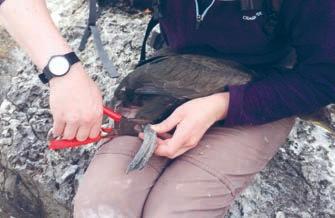
For most of the year, many of our seabirds live their lives far from land, at the mercy of the wind and the waves. It is little wonder that after prolonged periods of stormy weather seabirds may be washed up on our shores, sometimes in their thousands, in what are termed seabird ‘wrecks’. If any of these birds are ringed and subsequently reported, then we may be able to link these mass mortality events to impacts at their colonies. Recent studies of colour-ringed Shags (Acker et al. 2020) showed that severe winter storms disproportionately reduced survival rates of those individuals that remain near their breeding colonies during winter. Similarly, through long-term ringing studies of Guillemot populations, it has been possible to demonstrate how major oil-spill events have resulted in a doubling of winter mortality and reduced annual survival, with consequent impacts on populations (Votier et al. 2005).
Colour ringing of seabirds has proved invaluable in understanding their survival and movements, aided by both casual sightings and more intensive observations. Through the efforts of ringers, and those who put
Autumn 2022 18 — LIFECYCLE
FIELDWORK | Seabirds
A Shag being ringed with a pair of pliers that have been adapted to help those with less strength in their hands.
Ringing a Shag using adapted pliers, by Ros Green
many hours into resighting colourringed birds, much has been learnt about the annual movements of gull species across Europe and into Africa. Such studies are now being complemented by tracking projects for some species; however, there remains much to be learnt about both the demography and movements of these and other species, through ringing and observation.
By bringing together information on breeding success, survival and dispersal in population models, we can predict future population sizes and the potential impacts of key pressures, such as climate change or renewable developments. This is likely to be key to providing effective mitigation measures to improve the prospects for seabird populations.
AVIAN INFLUENZA
The emergence of Highly Pathogenic Avian Influenza (HPAI), which has affected so many of our seabird colonies this year, has highlighted the need for increased monitoring. If we are to understand the population impacts of HPAI then gathering information on changes in demographic rates, including survival, has never been so important. There are notable challenges, however, around ensuring that any activities at colonies do not compromise the welfare of birds and BTO is currently working on guidance in order to support our volunteers.
#OURLOSTSEABIRDS APPEAL
In 2020, BTO launched the #OurLostSeabirds appeal to raise funds to create the next generation of seabird volunteers. The first element of this project started with training courses on basic seabird identification and ecology. The second, which starts in 2023, will focus on seabird survey methods and will tie in with a proposed refresh of the SMP handbook. The third main area has been around increasing the number of people involved with seabird ringing, through training grants being offered to ringing groups and individuals seeking experience of working on seabirds.
Following consultation last winter with a number of seabird ringers, training material will appear on the ringing section of the BTO website over the next few months. This will include tips on how to get into seabird ringing and on locating new sites, and comprehensive guidance on how to organise seabird projects at both coastal and inland colonies.
In addition, we are looking at ways that we can make it easier for a wider range of people to use ringing pliers on larger species and are working on a design of an adapter that can be attached easily to pliers. We also hope to compile material to help promote different, but safe, methods for holding seabirds, recognising that not one size fits all when it comes to handling these powerful and often squirmy birds!
Thanks to everyone who has helped so far.
REFERENCES
Seabird Monitoring Programme
The SMP was started in 1986 as a means of capturing annual data from a subsample of sites across the UK for a wider range of demographic parameters. Up until that point, our understanding of population trends was limited to periodic complete censuses of colonies starting with Operation Seafarer (1969–70). This was followed up by Seabird Colony Register (1985–86), Seabird 2000 (1998–2002) and the current census Seabirds Count (2015–22).
www.bto.org/our-science/ projects/seabird-monitoringprogramme

Ringing on the Shiant Isles
Seabird ringing was started on the Shiants in 1970 by David Steventon and continued yearly until the mid-80s. The Shiants Auk Ringing Group was revived in 2008 by Jim Lennon who has encouraged partnership working with NGOs and academic institutions through sharing data on ringing, surveys and tracking. With advice from BTO, it now runs RAS projects for Puffin and Razorbill. It keeps one or two places free each year for new joiners.
Acker, P. et al. (2020) Strong survival selection on seasonal migration versus residence induced by extreme climatic events. Journal of Animal Ecology 90, 796–808.
Horswill, C. et al. (2018) When is enough enough? Effective sampling protocols for estimating the survival rates of seabirds with mark–recapture techniques. Bird Study 65, 290–298
Stanbury, A.J. et al. (2021) The status of our bird populations: the fifth Birds of Conservation Concern in the United Kingdom, Channel Islands and Isle of Man and second IUCN Red List assessment of extinction risk for Great Britain. British Birds 114, 723–747.
Votier, S.C. et al. (2005) Oil pollution and climate have wide-scale impacts on seabird demographics. Ecology Letters 8, 1157–1164.
LIFECYCLE — 19 Autumn 2022 Seabirds | FIELDWORK
Puffin RAS on the Shiant Isles, by Ruth Walker
Catching large gulls
Britain and Ireland host globally important breeding populations of seabirds; over eight million individuals. It is likely that you immediately imagine the sights, sounds and smells of some remote sea stack when you think of seabirds; however, the edge of a supermarket car park in the Midlands may be just as relevant, as large gulls have become a familiar feature in urban and inland areas. In this article, Gary Clewley and Graham Prole share tips and techniques for catching large gulls in the breeding season.
Simultaneously Red-listed and protected in Special Protection Areas but actively discouraged or controlled elsewhere, gull species, such as Herring Gull, often blur the lines between conservation and wildlife conflict, even ignoring for now the recurring sensationalist media interest. It is precisely because these species have undergone a substantial decline in some areas, but are deemed a nuisance in others, that makes them an interesting and relevant group for which to collect data to help us understand them better.
Most ringed gulls are caught as chicks, when productive visits can be made to traditional coastal breeding colonies and large numbers may be caught by hand, but there are also some great examples of longterm projects, such as the colour ringing of urban birds in Bristol since the 1980s, that provide valuable data from other habitats. We also know quite a lot about winter movements from adult birds caught in good numbers outside the breeding season. Far fewer breeding adults are ringed, however, and by 2020 there was only a single active RAS project for each of the three large gull species. There is huge potential to extend
the network of gull projects though, at a range of both coastal and inland sites.
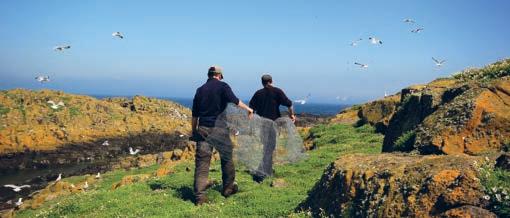
CATCHING ADULTS
The tips below come mostly from experience with Lesser Black-backed and Herring Gulls. Walk-in traps pegged down over the nests can be very effective for catching adult gulls and are covered under conventional traps on your ringing permit. These traps will be most effective a couple of days prior to hatching, when birds are really keen to get back on eggs to incubate. A week or so before can still work, but you may find birds loaf nearby or leave the nest area. The first half of the incubation period should be avoided completely due to a higher risk of desertion or of other gulls predating unattended eggs. The response to disturbance varies by colony (and areas within a colony), so knowing the site is very important for selecting the most suitable areas.
If the bird shows a clear preferred way onto the nest, set your entrance facing this direction. This isn’t always clear, however; in which case set the entrance facing the direction from which you will approach.
Autumn 2022 20 — LIFECYCLE
Constructing traps from lightweight chicken wire makes them easy to transport into and around a colony.
MONITORING | Catching gulls
Trapping gulls, by Steve Willis
I set the trap with the nest cup slightly closer to the entrance (not perfectly in the middle) so there is extra space behind the nest. This allows the bird space to move off the eggs when you approach to extract it. From many hundreds of nests trapped, we have found the risk of adults damaging the eggs to be extremely low. I generally set the funnel entrance around 12–16 cm wide as you want the birds to be able to push their way in and get back to the nest. If you set it too wide, you are more likely to get the bird in but equally more likely they will escape before you get there: I prefer not to catch, and move on and try again another time, rather than catch the bird and have it then escape.
To reduce overall disturbance and the number of visits into a colony, you can set several traps at the same time. Once a bird has found its way through the trap entrance and is incubating, you can leave it while waiting for others to also go in their traps (until disturbed the bird doesn’t mind being in the trap!). It is important to keep all traps under observation though, or have someone in the distance with a scope and radio, for if one of the birds in the traps becomes unsettled and is trying to escape it will deter others in the area and increase stress and risk of injury, so must be extracted immediately. Generally speaking I will expect to catch in about two thirds of the traps I set, and if I have not caught after 30 minutes, I move the traps and try other nests, and don’t return to the same area of the colony within the same session.
TRAP DESIGN
Initially, we spent quite some time making traps out of solid coated weldmesh, which looked very neat. These would be suitable for sites where traps could be stored nearby but are cumbersome to move. Subsequently we switched to using a lighter-gauge chicken wire. We found no difference whether PVC coated or not, so long as the traps are checked and kept in good condition, with no sharp edges anywhere; we usually make up new traps each season. These lightweight traps can look very flimsy and much less ‘professional’ but we found they had several advantages: they had more flex in the shape so could be moulded to fit any
Using wire with a smaller mesh size (e.g. 13 mm) is beneficial as this prevents birds getting their bills caught through the mesh. The lightweight wire also allows traps to be set in awkward places.
terrain, and far fewer birds escaped once in. Additionally, several traps can easily be rolled up and placed on a backpack when ease of transport or access to more remote colonies is needed.
A 3 m length of chicken wire is ideal for making a trap. The wire is rolled into a circle or heart shape, with a funnel entrance, and the top folded over and secured with cable ties. A larger starting length tends to make traps quite awkward to extract from, as birds are beyond arm’s length, and a smaller starting length results in birds being more reluctant to enter.
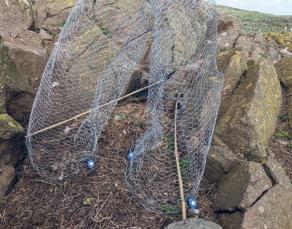
Other trap options, including large Potter traps and spring traps, can also be very effective, especially if you want to have some control over which individual is caught (if triggered directly by the ringer). These options often need quite flat and even ground, however, which is not always easy to come by in a natural colony.
PULLI RINGING
The following is written from Graham Prole’s experience with Great Black-backed Gulls, but much of the advice is just as relevant for the other large gull species.
Timing The laying time, and therefore the ideal time to start ringing pulli, differs
WALK-IN TRAPS
We have found walk-in traps to be very flexible in terms of where and how you set them and ideal if moving between colonies in different habitats. We have used walk-in traps in dune and shingle systems, upland peat bogs, saltmarsh and various urban sites including rooftops. It is important to peg down the traps with suitably solid pegs for the substrate so it doesn’t topple over when a bird is inside. If trapping on solid ground, you can slide small bamboo canes or similar through the mesh, extending outside the trap, and weigh them down with something heavy.
LIFECYCLE — 21 Autumn 2022 Catching gulls | MONITORING
Walk-in trap in situ, by Gary Clewley
You can expect over 40% of the birds you ring to be resighted; however, some of those 40% may not be seen until 5–10 years after ringing. Gulls are long-lived birds and colour ringing them is a long-term project.
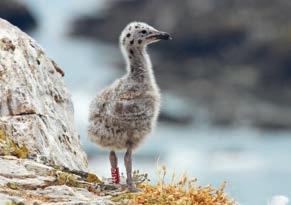
Gull pulli, the huge bill is an obvious giveaway.
WELFARE
The adults are often unimpressed by your presence in the colony and show their displeasure by divebombing you. They can spray you with guano, but also strike, so hats, preferably thick padded ones, are advisable even on the warmest days. We go for speed and quantity when we are in a colony and therefore do not stop to take additional biometrics, other than a few weights. Why? As we don’t know when they hatched, and are unlikely to capture them again, taking additional biometrics would gain little useful information and prolong our time in the colony.
each year and on each of the five islands off the Dublin coast that I monitor, so recce trips are important. Most years, Great Black-backed Gull pullus ringing starts at the beginning of June. Disturbance to incubating pairs can be minimised by waiting until all eggs have been hatched for a couple of weeks, by which time chicks will be left unattended for periods by both parents.
We try to time our ringing visits for when there are enough chicks that are big enough to take our colour rings (when primary feathers are at least one third grown). The larger colonies have a pecking order: the higher slopes seem to be prime real estate, first to nest and first to hatch. Peripheral nests further down the slopes can be weeks behind.
Location Typically on the Dublin islands, the Herring Gulls occupy the steeper slopes and ledges and the Great Black-backed Gulls the flatter ground where there is cover, but generally short vegetation. There are always exceptions to this, though, with a Herring Gull nesting in the middle of a Great Black-backed colony or vice versa. It can be difficult to tell the species of gull chicks apart until their plumage develops, so recce work to know what’s where on an island can be informative and for Great Black-backed
The colony is a brutal place. Chicks leave the nest after a couple of days and hide close by. When observing, I have seen young chicks stray into another pair’s territory and the adults attack them, sometimes fatally, and I have seen neighbours’ chicks swallowed whole. Therefore, when there are just two of us working in the colony, we ring chicks where we find them; however, when there are six or eight of us working through the colony, we establish a temporary ringing point. Ensuring young chicks are returned to the exact location they were collected from is critical, so helpers leave their rucksack where they find a chick and then return it to the same spot. We move on every 20 minutes to minimise disturbance in any one area of the colony. Despite their size, Great Black-backed Gull chicks are more docile than Herring Gull chicks and many have the belief that if they can’t see you, you can’t see them. Often you find them with their head in a crack and their whole body sticking out!
CATCHING
We mostly catch chicks by hand, but use nets for the faster ones and for carrying them. Although they can still draw blood should you offer them a finger or wrist, they lack the power of the parents. The rule still applies; don’t let their bill within striking distance of your face or anyone else, especially when passing birds for processing. Keeping them 45 cm (18 inches) away from eyes is essential.
WHY GULLS?
Gulls have long been associated with humans and have proved to be adaptable at exploiting new resources, and will likely continue to be for a long time to come. Mitigating future conflicts between people and gulls will be best achieved by placing good evidence at the heart of decision making, and collecting demographic data through the Ringing Scheme is an excellent way to contribute to that. I can think of few species that overlap so much with so many themes in current ornithology, so you will no doubt find something to suit your interests once you start looking.
Autumn 2022 22 — LIFECYCLE MONITORING | Catching gulls
Colour-ringed Great Black-backed Gull, by Jan Rod
Happy anniversaries CES & RAS
This year marks the 40th year of CES and the 25th year of RAS. To celebrate, Martin Hughes, Lloyd
experiences of taking part in these important projects.
CES & RAS IN NORTHUMBRIA
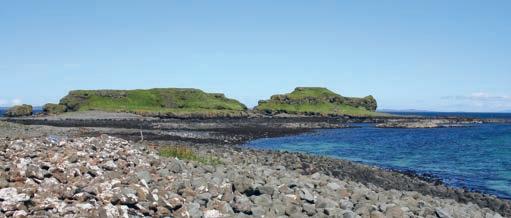
I suppose I’m a CES ringer, if I fit into any category; and it was always likely to be so. My first ringing session was a CES visit; and, given my trainer was Chris Mead, his CE site was no small affair but one where the net rides seemed to stretch for ever, with an equally impressive catch. Since those halcyon days I’ve ringed at a number of other CE sites but always hankered after my own. My first CES started in 2007 on a Durham Wildlife Trust (DWT) reserve. It’s in wet scrub and was followed in short order by a site on the fringe of an upland reservoir (Derwent) in Northumberland. The two sites were contrasting but complementary, with a suite of species that supplemented each other: Reed and Sedge Warbler, Reed Bunting, Willow Tit and Whitethroat at Rainton (DWT) and Willow Warbler, Redstart, Chaffinch and thrushes at Derwent. I found real satisfaction in following the fortunes of their birds and having the opportunity to instigate action when declines occurred. Not only am I recording valuable data without observer bias, I suggest solutions to conservation concerns and establish the results.
Two sites should be more than enough for anyone but, as I started reducing my working hours, I was approached to take on another site, by both DWT and Northumbria Water. In consequence, two sites became four. These were different again, upland scrub and a former landfill site. I catch scrub and Phylloscopus warblers in numbers on both and yet more Willow Tits (although there are nowhere near as many as I remember from my youth).
That, of course, was the absolute limit: it was not possible to operate any more single-handedly. Then Covid arrived, access was suspended and I started a Garden CES as a temporary substitute. With the easing of restrictions I could ring again on two of my sites that year and found I had time on my hands: I’d given up work and ‘only’ had three sites to do – and I gained access to another Northumbria Water site – so, just for the year, I set it up as a CES. Needless to say it still is: six in total now. It’s very hard work fitting in the visits but immensely satisfying. I’ve missed just 10 visits, including those lost to Covid, with over 500 completed. It’s a great training regime and my trainees and C-permit holders seem to
When people start training they often ask ‘what’s the best bird we could catch?’. On my sites I’ve caught a total of 77 species so there’s a deal to pick from, but my personal highlight was the Fieldfare caught on visit six that I dismissed as ‘just another Mistle Thrush’ before I sprinted to it as realisation set in.
LIFECYCLE — 23 Autumn 2022
Some RAS projects are carried out in wonderfully picturesque locations, like this mist-netting site for the Storm Petrel RAS on Lunga, Treshnish Isles.
Park and Robin Ward share their
CES & RAS | PROJECT RINGING
Storm Petrel mist-netting site on Lunga, Treshnish Isles, by Robin Ward
It’s been a privilege to witness the change in bird populations over time as Rutland Water Nature Reserve developed; in particular Nightingale and Cetti’s Warbler are now regularly heard and caught on CES visits, having not been before. The Rutland Water CES owes its success to the dedication of the members of the Rutland Water RG along with the Nature Reserve team and volunteers that have assisted in many ways over the years, as well as the support from Anglian Water on behalf of whom the LRWT manage the nature reserve. I can’t thank everyone enough for their support and encouragement over the years.
enjoy CES as much as I do. It also means I do a lot of ringing.
I rarely have time for other ringing in the summer: apart from my two RAS projects. These run in my garden so I can fit the catching around the CES visits. My Jackdaw project commenced in 2006 and the Bullfinches five years later. I find Jackdaws endlessly fascinating birds and it’s a challenge to catch adults (almost all I ring are) consistently: so far I’ve caught about 1,300, 1.5% of the total of all Jackdaws ringed (although most are ringed as pullus). I use colour rings but Jackdaws are adept at destroying them (sometimes in under two years), hence I target birds with damaged or missing colour rings, occasionally with success. About half of all Jackdaw ‘subsequent encounters’ are mine, a cause of some satisfaction.
I’m sure most people think I’m mad – I probably am – but I can’t think of a more productive way of being so whilst spending my time ringing. Martin Hughes
RUTLAND WATER CES
When I joined the Leicestershire and Rutland Wildlife Trust (LRWT) as an Assistant Warden at Rutland Water Nature Reserve (RWNR) in 2007, I had already been introduced to the concept of CES as part of my experiences as a trainee ringer. Little did I know then that CES would come to play a huge part in my role and my ringing practice. RWNR incorporated bird ringing early on following its creation
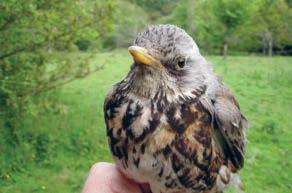
(in the late 1970s) as an important aspect of monitoring bird populations. Its longestablished ‘Lagoon 3’ site had by this time been a CES for a quarter of a century, having originally been part of the BTO’s Sylvia and Acros project. It hosts eight 60’ nets in double runs through woodland, wet scrub and Phragmites reed bed. In 2008, a second CES was established at the reserve; this is known as ‘Field 16’, named according to the field numbers that pre-existed the creation of the reservoir. This area of the reserve is now a mosaic of wetland habitats. It lies a few kilometres south of the Lagoon 3 site, and hosts 10 60’ nets.
In 2010, having recently gained my C permit, I was given responsibility for both sites with the support of the Rutland Water RG and I am proud to have kept both going until I left my role at RWNR in the autumn of 2020. As a result, CES became a big part of my life every year and I was rewarded with many memorable moments from interesting birds, to good company and close encounters with wildlife I wouldn’t have experienced otherwise.
During my 13 years of CES ringing, the anticipatory excitement I felt ahead of the sessions didn’t fade and I was always restless ahead of my 01:00 alarm, eager to get going. Putting up nets in the dark, hours before dawn, with the occasional Sedge Warbler tuning up is a fond memory; however, less so are the times the furthest guy cords snapped as I tensioned the net run resulting in me sitting in stagnant cold water, my thigh waders slowly filling, and wondering why on earth I do this for fun! But as the sun rises, wildlife awakens and the birds start to come in there’s always plenty of positives to distract from my soggy bottom half.
Some birds are still memorable; a German-ringed Sedge Warbler that I learned had been ringed in Djoudj National Park in Senegal, an Italian-ringed Reed Warbler that returned for three consecutive years to the same site having been caught in Italy in the May of the year I first caught it, and the time a trainee returned with a grin from ear to ear as they asked me to ‘guess the bird’ – a Wryneck, and a rarity for me. Catching rarities during CES never ceases to be an exciting moment, but for me
Autumn 2022 24 — LIFECYCLE PROJECT RINGING | CES & RAS
Unexpected Fieldfare, by Martin Hughes
the greatest satisfaction comes in knowing every bird caught within the study is just as valuable as the next, and there is great sense of pride when you read an article about British & Irish bird populations rising or falling and knowing that your efforts have played a part in our better understanding of national population trends. CES has played an integral part in my progression from trainee to Trainer and it has provided an ideal opportunity to pay this forward to my trainees. I would highly recommend taking the chance to participate in CES ringing. If you have the time and resources, making the commitment to undertake the 12 visits over the spring and summer is a great way to prioritise ringing in your calendar and push on to gain valuable experience and the regular practice you need as T- and C-permit holders.
Lloyd Park
TRESHNISH ISLES RAS
News reaches me as I write that the lethal spread of Avian Influenza is to prevent those of us ringing seabirds in Scotland from undertaking our RAS projects for a second time in recent years. Storm Petrel and Shag are the subject of three RAS projects by the Treshnish Isles Auk RG (TIARG). Because Storm Petrels are exceptionally long-lived birds (the BTO longevity record is over 38 years), the impact of missed years on survival trends is reduced. This attribute has allowed TIARG to commit to its two Storm Petrel RAS projects, as it is not every year that there will be some nights of calm dry weather to allow mist netting within our annual one-week expedition to the Treshnish Isles, in late June.
The Treshnish Isles are an uninhabited group of terraced, Tertiary basalt islands situated 3 km west of Mull, western Scotland. On one of the islands, Lunga, TIARG’s census of Storm Petrels in 2018 found an estimated breeding population of 3,251 pairs. We operate two Storm Petrel RAS on the north-east corner of Lunga; the same lengths of net are erected in the same positions each session, with two ends of one site operated on different days. One night of mist netting at each of the three netting locations is attempted annually, with no sound lure needed (or desired!). Great care does need to be exercised as large numbers
(up to 1,000) can be caught by just two nets in a single session, necessitating skilled mist-net extractors amongst our eightperson team. Head torches are not used during extraction as it can make the process more difficult. In addition, nocturnal observations on Skokholm have shown a marked reduction in the numbers of birds flying across a colony area when illuminated by a white-light head torch. As the survival rate for this species is good (79% nationally, 80–83% on Lunga) and it is site faithful, this species lends itself really well to RAS, even though the recapture probability is relatively low at 8–18% on Lunga.
For our 16-year-old RAS study of Shags, all adults are caught by hand at the nest. A single engraved Darvic colour ring is placed on the bird’s left leg. Over 400 Shags are now individually identifiable in the field without the need for recapture. Resightings of the birds during our annual visits have provided an average annual re-encounter probability of 55% for males and 58% for females. A high adult survival rate is to be expected in this species, which on Lunga is 84% for males and 88% for females.
There is an urgent need for additional RAS studies to be instigated in order to measure changes in adult survival in response to effects associated with offshore anthropogenic activities (Cook et al. 2019). That TIARG has been able to operate its RAS projects in the long term, on a tight time budget, will hopefully encourage others to start up a RAS project that adds to the single other active projects that exist for Shag and Storm Petrel. Robin Ward
REFERENCES
Cook, A.S.C.P. et al. (2019) Review of the potential of seabird colony monitoring to inform monitoring programmes for consented offshore wind farm projects. Research Report 712. British Trust for Ornithology, Thetford.
Since having been approached by the BTO to formalise our ringing of the species from 2011, we have surprisingly been able to maintain and sample our breeding population of metal-ringed Storm Petrel in all years prior to this one. Furthermore, we have been able to include our historical data in both RAS studies, from a dataset that began in 1974. The monitoring of seabirds and other bird species by TIARG on the Treshnish Isles have been published annually since 1998. The reports are available online at: tiarg.org
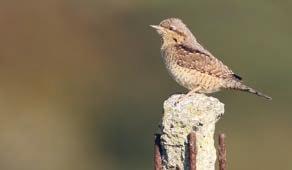
LIFECYCLE — 25 Autumn 2022 CES & RAS | PROJECT RINGING
Wryneck, by Liz Cutting/BTO
Wintering Blackcaps
COLOUR RINGING
In this study, the large quantity of invaluable resighting data is partly down to the number of birds marked but more importantly due to the considerable efforts of the dedicated observers checking all birds present at their sites throughout each winter. This was achieved through providing project publicity to make garden observers near study sites aware, as well as alerting the BTO Garden Birdwatch network to check their feeders.
Wintering Blackcaps have become a regular sight in many British and Irish gardens, where these typically shy warblers show a fondness for fat balls, sunflower seeds, and other food items (Plummer et al. 2015). It used to be thought that wintering Blackcaps travelled to Britain and Ireland from central Europe, but we now know that their breeding origins span much of the continent, from Spain to Poland (Delmore et al. 2020). These migrations are highly unusual, as Blackcaps that breed in Europe otherwise migrate south to the Mediterranean and northern Africa for the winter. What exactly are these atypical winterers up to during the winter months?
THE STUDY
Over the course of four winters between 2016/17 and 2019/20, a network of dedicated ringers marked a total of 623 Blackcaps with colour rings across Britain and Ireland. Thanks to regular observations at ringing sites, an impressive total of 357 marked individuals were resighted either during the same or subsequent winters. These observations, plus additional sightings from a long-running study by Graham
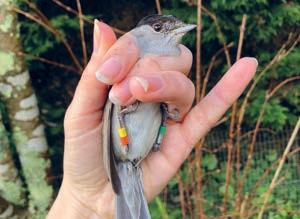
Roberts, totalled nearly 10,000 Blackcap encounters. The study also included data from 25 birds tracked with geolocators, miniature tracking devices that determine a bird’s location based on ambient light levels. BTO also provided information on ring recoveries and recaptures in Britain or Ireland during the winter period. Taken together, these data provide a new window into the lives of wintering Blackcaps.
WHEN DO WINTERING BLACKCAPS MOVE?
Wintering Blackcaps typically appear in gardens in November and December; however, thanks to geolocators, we now know that this is not the whole story – they actually arrive in Britain and Ireland many weeks earlier. Most tracked birds arrived between late September and mid-October, but they were not actually observed in gardens until around six weeks after their return. We believe that wintering Blackcaps may initially feed on natural food sources outside gardens, such as fruit and berries, and only appear at bird feeders once these food sources have been depleted. In spring, the picture changes: tracked Blackcaps were observed in gardens up until a few days
Autumn 2022 26 — LIFECYCLE 50°N 52°N 54°N 56°N 8°W6°W4°W2°W 0° 2°E
Sites where wintering Blackcap were individually colour ringed between winters 2016/17 and 2019/20 (small dot = 1; largest dot = 200)
RESEARCH | Blackcaps
Bird feeders, fruiting plants and a warming world are influencing the movements and morphology of Blackcaps that winter in Britain and Ireland. Benjamin Van Doren and Greg Conway summarise the results of a recent study.
Blackcap with colour rings, by Ellie Ness
before they departed on migration. Garden food resources therefore likely play a key role in fuelling the migration of Blackcaps back to their breeding sites.
DO THEY RETURN TO THE SAME GARDEN?
Around 40% of adult Blackcaps wintering in Britain and Ireland returned to the same sites in subsequent years, but only 24% of first-year birds did so. Both of these figures are much higher than estimates from Mediterranean wintering sites, where typically only 0–5% of Blackcaps return in subsequent years. Evidently, garden bird feeders are a key resource that keeps our wintering Blackcaps coming back.
Ringing data revealed that wintering Blackcaps can be very mobile during November and December, moving tens or hundreds of kilometres (see plot below). As winter settles in, so do the Blackcaps: from January to March, the great majority remain at their winter site. In subsequent years, those that don’t return to their previous winter site may move considerable distances, on average 150 km. Interestingly, one individual that was resighted regularly throughout an entire winter subsequently relocated over 50 km to a new site the following winter.
WHY DO THEY USE GARDENS?
The largest numbers of Blackcaps were seen in gardens during midwinter (Feb–Mar). Weather is an important factor influencing when they visited gardens. Throughout the winter, Blackcaps were more likely to be seen in poor weather, involving low
temperatures and rain. These conditions may make it more difficult to find natural food sources and increase energy demands.
DOES FEEDING IMPACT THEIR PHYSICAL CONDITION?
Adult Blackcaps that frequented gardens carried less fat and had better overall body condition than those that visited intermittently. Gardens provide a reliable source of food, allowing these birds to remain leaner. Leaner birds are more manoeuvrable when escaping aerial predators, which is a frequent danger around feeding stations. This pattern was reversed for first-year birds, which may rely on gardens when they are in poor condition.
Another very intriguing finding was a difference in morphology for adults that frequented gardens. These birds were typically longer-billed with a more rounded wingtip, both adaptations for more generalist feeding and sedentary behaviour.
FUTURE PROSPECTS
The success of Blackcaps’ northern wintering strategy can be seen in the proliferation of birds now spending the winter with us. Although this is partly driven by a warming winter climate, the combination of a reliable winter food resource and an earlier return to breeding sites may provide these birds with an advantage over their traditional southernmigrating counterparts. The trend of increasing wintering numbers appears to be set to continue, but these warblers may still be vulnerable to extreme winter weather.
REFERENCES
For further details of this study see: Van Doren, B.M. et al. (2021) Human activity shapes the wintering ecology of a migratory bird. Global Change Biology 27, 2715–2727. Delmore, K.E. et al. (2020) Individual variability and versatility in an ecoevolutionary model of avian migration. Proceedings of the Royal Society B 287, 20201339. Plummer, K.E. et al. (2015) Is supplementary feeding in gardens a driver of evolutionary change in a migratory bird species? Global Change Biology 21, 4353–4363.
ACKNOWLEDGEMENTS
We are grateful to the large number of ringers, homeowners and public contributors to this project over the years. Special thanks to Robbie Phillips, Glynne Evans, Graham Roberts, Miriam Liedvogel, and Ben Sheldon for key scientific contributions.
LIFECYCLE — 27 Autumn 2022
Blackcaps | RESEARCH
0.1 1 10 100 1000 NovDecJanFebMar Date of initial encounter Distance moved (km) 1 2 DecJanFebMarApr Date Predicted number of blackcaps 0.1 0.2 0.3 0.4 0.02.55.07.510.012.5 Air temperature (C) Probability of observation Distance moved (km) Date of initial encounter Date Air temperature (˚C) Predicted number of Blackcaps Probability of observation a b c When do wintering Blackcaps move (plot a), when do they use gardens (plot b) and perhaps why (plot c).
Barnacle Geese in a changing world
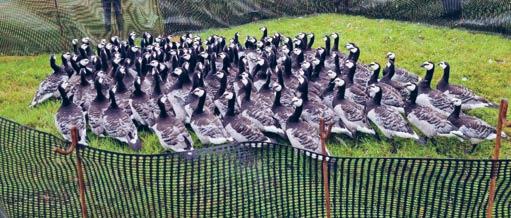
Britain hosts three populations of Barnacle Geese. The Greenland and Svalbard breeding populations are entirely migratory, and only spend their winters on our shores. The third population is naturalised, and occurs here all year round. In this article, Kane Brides, Scott Petrek, Stephen Vickers and Richard Hearn introduce a new project to understand more about the movements and demography of this naturalised population.
COLOUR RINGS
Birds have been colour marked with an engraved blue ring with an alphanumeric code in white lettering (e.g. A96). On the opposite leg the birds are ringed with a metal ring, along with a plain colour ring, either above or below the metal ring to denote the ringing site. In 2022, yellow alphanumeric leg rings or white alphanumeric neck rings have also been used as part of this project.
The population of Barnacle Geese migrating from Greenland tends to winter on the west coast of Scotland and Ireland, with the bulk wintering on the Isle of Islay, whilst those migrating from Svalbard winter chiefly on the Solway Firth, with smaller groups occasionally wintering on the coast of northeast Britain. Most of the naturalised population is found in England and Wales, with smaller numbers occurring in Scotland. Presumably originating from a mixture of once-captive stock, immigrants from the Netherlands/Russian population or injured birds that no longer migrate, the naturalised population is estimated by WeBS to number around 4,000 birds (Frost et al. 2021).
RINGING OF BARNACLE GEESE
Not surprisingly, the capture and ringing of Barnacle Geese in Britain & Ireland has mainly been focused on the two migratory populations, with both having been extensively studied over the years, the Svalbard population being so since 1973! Principally in the UK, cannon netting has been used on the wintering grounds to colour mark samples of individuals from both migratory flyways. These help bolster
the overall number of individuals marked, as many are also captured and colour marked on the breeding grounds (mainly on Svalbard), where large numbers can be rounded up when flightless during their annual moult.
To date, the naturalised population has received little attention by way of colour marking on a large scale. Individual projects in Scotland (run by Carl Mitchell), Wales (by SCAN RG / Steve Dodd) and Bedfordshire (by the Ivel RG) have, over the years, provided fascinating glimpses into the movements of our so-called ‘resident’ population.
Colour marking has shown that birds marked at Ynys-Hir in Wales are linked with the breeding population in the Lake District, with birds moving c. 230 km each spring to Cumbria (Dodd et al. 2017). Those marked in Bedfordshire have been known to cross the English Channel, with sightings received from France (M. Reed pers. comm.), whilst goslings hatched and raised in Scotland have been sighted in Norway and Iceland, seemingly having joined their wild migratory counterparts (Mitchell et al. 2021).
Autumn 2022 28 — LIFECYCLE FIELDWORK | Barnacle Geese
When flightless, the geese are rounded up into pens ready to be ringed.
Rounded-up Barnacle Geese prior to ringing, by Kane Brides
BARNACLE GEESE IN A CHANGING WORLD
The populations of the three migratory Barnacle Goose populations in Europe (Greenland, Svalbard and Russian) have dramatically increased over the last half century and, because of this, there are concerns regarding the potential impact on other flora and fauna, especially on Arctic ecosystems (Jensen et al. 2018). In some countries, the species is causing increasing damage to agriculture and posing greater risks to air safety. The development of an International Single Species Management Plan (ISSMP) was identified as a priority and undertaken by the Agreement on the Conservation of African–Eurasian Migratory Waterbirds (AEWA; Jensen et al. 2018).
Given future management of the wild migratory populations, it would be advantageous to improve our understanding of any connectivity that occurs between the migratory and naturalised populations, as is being studied in other European countries. As already demonstrated by Mitchell et al. 2021, confirmation already exists that Scottish-hatched Barnacle Geese are mixing with migratory flocks. In the Netherlands, intensive ringing has shown that birds from the Russian population have stopped migrating altogether and expanded their breeding range, with once-migratory birds now breeding there (which is still the wintering area for most birds) and resident year round. Is this a future glimpse into how other goose species may react to increasing populations and food availability? Furthermore, colour-marked birds from the Dutch naturalised population have already been sighted in Britain.
Despite flocks being found at sites across Britain, much still remains unknown about the movements and demography of this naturalised population. The absence of such fundamental information, such as data on movements, survival and mortality, has hindered efforts to understand the demographic causes of the observed increase in population size.
NEW COLOUR-MARKING PROJECT
To deliver up-to-date information on this population, volunteers from the Waterbird Colour-marking Group have embarked on a new colour-marking project, with the aims
of (i) better understanding movements between naturalised subpopulations in Britain, (ii) assessing whether connectivity between our naturalised population and other populations in Europe occurs and to what degree this happens and (iii) producing the first survival estimate for this population.
As wildfowl species undergo a complete moult, which renders them flightless for several weeks each year, large numbers can be rounded up, caught and ringed at one time, to allow further study. In July 2021 we conducted our first roundups, and it is hoped these will continue for several years at sites across England and Wales.
The catches were a great success, with the team starting at Ullswater in the Lake District, Cumbria, where 158 birds were rounded up, including a bird that had been ringed at Ynys-Hir, Powys, Wales. Calling upon local ringers and groups to help with ringing effort and to cut down on travel due to Covid-19 precautions, a further 35 birds were caught in Cleethorpes, Lincolnshire, 431 at Holkham and 106 at Pensthorpe in Norfolk, followed by 46 birds colour marked with the Llangorse Ringing Group in Powys. These catches, along with attempts at catching breeding birds earlier in the year and further catches in 2022 have resulted in over 1,500 Barnacle Geese being caught and colour marked.
FUTURE CATCHING & SIGHTINGS
As we intend to catch and colour mark birds for a number of years, we are looking to expand catching efforts, to incorporate other sites in areas where naturalised Barnacle Geese occur. We are asking ringers who know of sites that host Barnacle Geese in England and Wales, where ringing could potentially take place (moult roundups, cannon netting, catching breeding birds etc.) to get in touch to discuss potential collaboration (please contact kanebrides@ gmail.com). Of course, sightings of colourmarked birds are most welcome and to help with the expected volume of resightings as the project grows, we have created an online resightings/histories feedback portal, www. waterbirdcolourmarking.org/barnaclegoose with sightings also being sent to BTO to be included in the national dataset.
REFERENCES
Dodd, S.G. (2017) Colour-ring resightings and flock counts link the increasing Welsh wintering Barnacle Goose Branta leucopsis flock to a naturalised breeding population in the Lake District. Ringing & Migration 32, 54–57.

Frost, T.M. et al. (2021) Waterbirds in the UK 2019/20: The Wetland Bird Survey. BTO/RSPB/JNCC. Thetford.
Jensen, G.H. et al. (Compilers) (2018) AEWA International Single Species Management Plan for the Barnacle Goose (Branta leucopsis) - Russia/Germany & Netherlands population, East Greenland/Scotland & Ireland population, Svalbard/South-west Scotland population. AEWA Technical Series No. 70. Bonn, Germany.
Mitchell, C. et al. (2021) Movements of naturalised Barnacle Geese ringed in Strathspey. Scottish Birds 41, 3–9.
LIFECYCLE — 29 Autumn 2022 Barnacle Geese | FIELDWORK
Colour-ringed Barnacle Goose, by Andy Bloomfield
Your new-look Ringing Committee
Ringing Committee looks very different in 2022 compared to last year, with a new Chair, five new members and new T- and C-permit representatives. In this article, Lucy Wright, the new Chair, introduces herself and shares her thoughts on the role of RIN and the future of the Ringing Scheme.
What does ringing mean to you? For me, it’s about collecting data that help bird conservation, the privilege of being able to handle birds and spend time in amazing wild places, sharing knowledge and skills (both by learning from and training others) and enjoying time with a group of people who have a shared interest and purpose: conservation, connection to nature, learning, and friendship. I am really pleased to be taking on the role of Chair of the Ringing Committee, to support the excellent work that you all do as ringers, in partnership with BTO.
A key role of the Ringing Committee is to help the partnership between ringers and the wonderful BTO team to run smoothly, for example by gathering views from ringers and communicating between ringers and staff. For more information on how the Ringing Committee works and how you can feed in ideas, take a look at the ‘RIN function review’ paper (Item 5 in the agenda and papers for last October’s Ringing Committee meeting, available on the ringers-only pages of the BTO website). With thousands of ringers having a diverse range of ideas about where the Scheme should go next, and limited resources
in the BTO team, it won’t always be possible to act on everything you’d like us to do (even if we think your idea is brilliant), but suggestions are always welcome, and we can add the best ones to the list.
I believe that diversity, in all its forms, makes us stronger, and I want to ensure the Ringing Scheme is welcoming and accessible to all. I am the first female Chair of the Ringing Committee in its 85-year history (yes, it has taken until 2022). I’m pleased that we now have a much more representative gender balance in the Scheme, particularly in younger ringers. This is a step in the right direction, but gender is only one form of diversity and by all other measures we have a long way to go to become more inclusive and diverse. We know that conservation is one of the least diverse sectors in the UK and the Ringing Scheme reflects this. Have a think about what you can personally do to make your ringing more inclusive, and to encourage those from under-represented groups to join in. I don’t have all the answers but you’re an inventive bunch, so please share any ideas you might have about how we can improve diversity and inclusion in ringing in the future.
ABOUT ME
I’ve had a lifelong interest in birds and began ringing in my early 20s, starting out at Chew Valley (passerines) and Slimbridge (wildfowl), then doing a PhD on Woodlarks where I learnt about nest finding and pullus ringing. I joined the Wash Wader RG about 20 years ago, and I now have a cannonnetting endorsement for waders and regularly lead wader-catching fieldwork. I work for the RSPB, where my job includes running seabird-tracking projects. I bring a different perspective to the Committee as someone who mostly rings non-passerines.

The thing I most regret saying as a ringer is ‘Wrens are quite easy to extract’ (very early in my ringing career; the Chew Valley folks have never let me forget). I also have a talent for finding the muddiest spot in any ringing site, usually by falling in it!
THANK YOU
Huge thanks to the outgoing Chair, Ian Bainbridge, RIN members John Black, Adrian Blackburn, Stephen Hunter and Paul Roper and to T- and C-permit representatives Imogen Lloyd and Alex Dodds for their valuable contributions during their time on RIN.
Autumn 2022 30 — LIFECYCLE COMMUNITY | Ringing Committee update
INTRODUCING YOUR NEW RIN MEMBERS
JIM LENNON
I got into ringing in my 30s. I started training in 1991 with the Severn Vale RG but since the millennium have been based in Nottinghamshire; all my ringing has been in Britain & Ireland. I am endorsed for, and train, most types of ringing bar cannon netting (although I have helped at lots of catches) and have been involved in about 20 BTO ringing courses.
My ringing includes seabirds on the Shiant Isles where we run four seabird RAS projects, farmland birds in the winter with local students who use the data as part of their studies, heron and egret pulli, a few hundred owl and Kestrel boxes plus garden ringing as a training tool. Most of these include colour ringing, and we’re working with Seatrack using geolocators on auks and Shags on the Shiants. My ethos is not just to ring birds, but to maximise the information we get from them through RAS, colour ringing and so on.

Often, I believe the ‘answer is in the room’ and that we ringers have a lot to contribute to producing good practice. I see part of my input at Ringing Committee as getting this good practice out there.
I helped BTO organise the Trainers’ workshop in 2019, and have been involved in their work to increase seabird ringing and the guidance linked to this. Through my work at Natural England (ex-Countryside Agency) and RSPB I want to bring my experience of public and voluntary sectors to the Ringing Committee on, for example, governance, partnership and funding issues.
I’m honoured to be asked by BTO to serve on the Ringing Committee for the next four years. However, I don’t see it as a badge of honour, but an opportunity to get stuff done for the benefit of ringers and the Scheme.
PETER KIRMOND
The pandemic challenged everyone, from individuals to entire organisations. As a new member of the Ringing Committee I hope to be able to help ensure the Ringing Scheme thrives in the changed world we are now part of.

My ringing career has been very much a game of two halves: I became a trainee in the 1970s under the expert eye of John McMeeking. A decade of varied activity included the early days of ringing at Treswell Wood, numerous Wash Wader Ringing Group trips and time as assistant warden at Dungeness.
Work and family led to a 30-year sabbatical and I returned to ringing five or so years ago. This return has included, amongst other things, CES at WWT Slimbridge, spells at Gibraltar Rock Bird Observatory, a Kestrel nest-box monitoring scheme, a colour-ringing House Sparrow RAS and winter ringing project in our garden, and a community-based Swift nestbox scheme around our village which, I hope, in time will also become a RAS.
My two-part ringing career gives me, perhaps, a different perspective from many
others: a long familiarity with ringing culture combined with a fresh eye. The growth of CES and RAS has done much to increase the value of the data we collect but I feel that to justify the continuation of the Scheme long term, we need to go even further in that direction.
My career as a pharmacist and GP surgery Practice Manager has given me many skills which I hope I can bring to the Ringing Committee to help me represent the voices of all ringers and help it balance ringers’ needs with the Scheme’s many other pressures.
Finally, the demography of ringers themselves needs to be broader and more diverse: I cannot influence the demographic I belong to (the rather over-represented white, male and middle aged) but I can do my best to nudge the Ringing Scheme towards being more representative of society as a whole.
We need to encourage a lifelong commitment to ringing from a wider range of people even if that means, like me, it comes with interludes.
LIFECYCLE — 31 Autumn 2022 Ringing Committee update | COMMUNITY
RICHARD DU FEU
My ringing career began while I was at school, initially trapping in a back garden and in Treswell Wood. I moved to Lancaster in 1997 as a student, started ringing with North Lancs Ringing Group and took on the group’s long-running Sand Martin study a few years later. Most of my ringing is now of waders, both in the UK and internationally, with the Sand Martin RAS taking up the months when many waders are away.
I am involved in colour ringing several wader species and a long-term effort to submit biometric data from the Wash Wader Research Group to BTO. Although there are many magical moments in the field, the greatest part of ringing for me is seeing the end results of the data. None of this would be possible without great tools for data handling, such as IPMR and DemOn, nor the
ROGER WALSH
I first experienced bird ringing while working as a Voluntary Warden on Skomer Island some 45 years ago and, subsequently, spent three seasons as an Assistant Warden on the Farne Islands, broadening my ornithological experience further. I continued to develop ringing expertise and knowledge over the following years with fieldwork and projects both in the UK and abroad.

Early experiences of seasonal conservation work helped shape my decision to become a teacher. For 35 years, including over 17 years as a head teacher, I followed my career in education. Not only was I able to pursue my keen interest in ornithology as a hobby but I was also able to use my knowledge, skills and passion for ringing to motivate children’s interests in wildlife and conservation. My leadership, management and development skills from teaching have seamlessly transferred into my role as a BTO Trainer.
Since 2011 I have been involved in studying migratory and resident species in West Africa, participating in, and now leading, regular expeditions to the

huge effort from ringers, WeBS counters, colour-ring readers and many other field workers.
The evolution of the Ringing Scheme is critical to its long-term success. Since I started to ring in the early 1990s there has clearly been a huge shift within the Scheme from counting every record (annual totals, age-specific totals etc.) to making every record count, with all records (new, retrap and biometrics) being submitted electronically. I hope to continue supporting the Ringing & Nest Recording Team by helping this evolution continue while ensuring data availability to ringers continues to improve.
Please do get in touch – all RIN members are there to make the Ringing Scheme better for ringers and the sciencebased conservation that ringing provides so much valuable data for.
Kartong Bird Observatory in The Gambia. A particular focus there has been the study of critically endangered vultures in the region, with a long-term study into the Hooded Vulture population under way. With a particular passion for seabirds, I have helped to lead trips to remote Scottish islands, as well as ringing expeditions to other islands around the British coast. Closer to home, I contribute to long-running ringing projects studying farmland birds, Barn Owls and Sand Martins in East Anglia. Through various colour-ringing projects, I am involved in studying the site fidelity, movements, survival and breeding success of Grey Herons, Little Egrets and Mute Swans. I constantly celebrate the diversity of the Ringing Scheme in Britain & Ireland as one of its greatest strengths because it encourages people of all ages and from all walks of life to get involved. The army of volunteers that provides the rich dataset for the BTO’s science also holds the organisation to account, so that all the information collected is used wisely and purposefully for the greatest benefit for conservation.
Autumn 2022 32 — LIFECYCLE COMMUNITY | Ringing Committee update
STEPHEN VICKERS
My first real taste of bird ringing was at Skokholm Island Bird Observatory in 2017 (I know, not long ago!). A writing/ work retreat somehow ended up being hide and seek with gull chicks all week and ringing Manx Shearwaters into the night. I was hooked and I haven’t slowed down since.
I trained with Gower and Mid-Wales Ringing Groups, getting my C permit the following year whilst back on Skokholm as a long-term volunteer. I then moved to Norwich where I completed my PhD (mechanisms of connectivity, dispersal and range shifts in migratory birds), joining the University of East Anglia RG and ringing every spare minute I have. I got my A permit and Trainer’s endorsement (now S permit) the following year and I owe the speed of my progression through the Scheme to the wide array of ringers I worked and continue to collaborate with.
Now alongside training I lead or contribute to projects across a variety of species with a particular focus on
INTRODUCING YOUR NEW T-PERMIT REPRESENTATIVE
HAYLEY LAND
I am currently a student completing my fourth and final year of an integrated master’s degree in ecology and conservation at Lancaster University. I am passionate about wildlife and the environment and am hoping to begin a career in conservation on completion of my degree. I have a particular interest in ornithology and, through practical conservation volunteering at Foxglove Covert Local Nature Reserve in North Yorkshire, I began ringing with Swaledale Ringing Group. I instantly loved the experience and have now been a trainee for a couple of years.


As part of this group, I have been fortunate to ring with, and learn from, some very knowledgeable and experienced people. I mainly ring at Foxglove Covert, a long-term CES site with a mosaic of habitats home to a wide range of species. I have experienced completing nest
colour ringing and the Waterbird Colour Marking Group. I’m active across a wide range of techniques, including mist netting, dazzling (with and without a thermal imager) and hand catching.
In my spare time I have developed a range of online tools for ringers to use to explore the data in the annual online ringing report and their own ringing data, and I have also developed colourring reporting apps that give instant life histories (https://shvickers94.github.io/ BTO_Ringing_Apps/). During my time on RIN, I want to continue to develop such tools, and hopefully my position will enable me to work closer with both BTO staff and the ringing community in order to make this happen.
I hope my election to RIN can help to bring fresh perspectives, partly through my recent progress through the permit system and through my coding knowledge and subsequent ability to help bridge the gap between the wider ringing community and the DemOn development team.
records and pulli ringing at this site and last autumn I particularly enjoyed the opportunity to ring migrating thrushes, such as Redwing, as they passed through the reserve. I have also experienced ringing on the Catterick Training Area, a large expanse of MOD land on the edge of the Yorkshire Dales. Here I have been fortunate to encounter and ring different species, such as Buzzard, Black-headed Gull and wader pulli.
It is a privilege to have been offered the opportunity to become a member of RIN and to represent my fellow trainee ringers. I look forward to meeting new people and hope that my experiences will allow me to provide a new perspective on the Ringing Committee. I am keen to learn more about such an important part of the Ringing Scheme and to contribute to the sharing of knowledge and ideas between ringers.
LIFECYCLE — 33 Autumn 2022 Ringing Committee update | COMMUNITY
INTRODUCING YOUR NEW C-PERMIT REPRESENTATIVE
ALEX PHILLIPS
After a lifetime of interest in ornithology, I started ringing in 2013 with the South Notts RG and received my C permit in 2018. During the last few years, I have spent time ringing with North Notts RG, Sorby Breck RG and at Portland Bird Observatory. For the past seven years I have served as the treasurer to South Notts RG.
I previously worked in the European Parliament, where I worked on the Committee on the Environment, Public Health and Food Safety (ENVI) and in the House of Commons. I hope this experience will provide the Ringing Committee a unique perspective.
For the last 10 years I’ve worked in third-sector fundraising and Higher Education research funding. These skills
Into the Red
BTO ringers and nest recorders will be very aware of the long-term declines evident in many of our breeding and wintering birds; you will also be aware of the limited resources available to tackle these declines. Those working to tackle declines have to prioritise if they are to make the most effective use of the limited resources, directing them towards the best places for nature and the species most in need of help.
The periodic Birds of Conservation Concern review is one of the tools used to identify the priorities. The most recent review, published in 2021, placed each of the UK’s regularly occurring native species onto one of three lists, based on a set of standard criteria. There are ‘Red’ criteria, with thresholds for rates of decline in numbers and range, historical decline and international threat. If a species meets any of these criteria it is placed on the Red List, if not it is then assessed against Amber List criteria. If it doesn’t meet any of the criteria it is placed on the Green List.
While the listing process supports the setting of conservation priorities,
have been put to work, including obtaining significant funding for South Notts RG and others. I am keen to share my experiences with other ringing groups and individuals who may want funding or to improve their fundraising processes.

As we slowly move into the postCovid world, I will seek support for the creation of an open network of A- and S-permit holders who would be willing to spend time with T- and C-permit holders who would like experience of a specific species, or method(s) and improve wider knowledge exchange.
I look forward to hearing from C-permit holders on any issues affecting them and taking items forward to the Ringing Committee as their representative.
and is familiar to us, it is not well known more broadly, and that creates something of a challenge. If we want wider society to support conservation action, then they need to be engaged with the species that we are trying to help.
One way we can increase the profile of our Red-listed birds is to tell their stories in engaging ways, using the creative skills of authors, artists, musicians, poets, celebrities, and others. We did this very successfully following publication of the previous Red List, through our Red Sixty Seven book, and we have just launched a follow-up, Into the Red, to portray the 70 species on the current Red List.
The book, which features 70 artists and 70 writers, includes contributions from Nick Hayes, M.G. Leonard, Isabella Tree, Richard Mabey, David Gray, Jim Moir, Harriet Mead, Mackenzie Crook, Megan McCubbin, and many others. As well as raising the profile of our most at-risk birds, profits from the sale of this book will be donated to BTO and the Rare Breeding Birds Panel.
You can secure your copy of the book at a discounted price (£20 instead of £25) by visiting www.bto.org/ intothered and applying the discount code I2TRBTO

Autumn 2022 34 — LIFECYCLE
COMMUNITY | Ringing Committee update
Merlin, by Ruth Weaver. One of the 70 artworks featured in Into the Red
Working with Woodcock
Being a migratory and resident bird that inhabits deep shadowy thickets, leaving cover only to feed on fields in the safety of darkness through the winter months, it is not surprising that Woodcock have remained one of the least-researched birds in the UK. In this article, Owen Williams from the Woodcock Network explains why he is trying to get more people to monitor this elusive species.
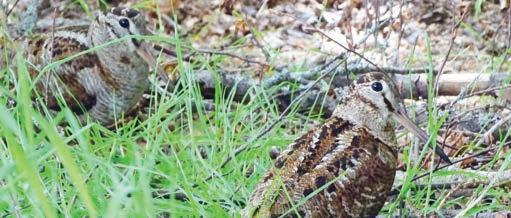
Woodcock became the first species in the UK to be studied by marking them with rings. In 1891, eight years before Hans Mortensen began his ringing of Starlings in Denmark, Lord William Percy commenced a ringing project to investigate if Woodcock fledged on the family estate at Alnwick Castle, Northumberland, remained loyal to their natal area. A total of 369 pulli were ringed between 1891 and 1908, but because his rings were marked only with the family monogram and the year of ringing, and not individually numbered as in Mortensen’s case, this has not been regarded as a proper ringing scheme.
THE WOODCOCK INQUIRY
In 1934/35 one of the first studies conducted by the newly formed BTO was the Woodcock Inquiry which was run in conjunction with the Edward Grey Institute of Field Ornithology at Oxford University. This investigated the population status of Woodcock in Britain & Ireland, which was complicated by having both a small population of resident breeding Woodcock and an estimated 1.2 million winter migrants that arrived from Russia
and Scandinavia in early November and departed to breeding grounds in early March. The Inquiry sent a wide-ranging questionnaire to landowners, natural history clubs and to the readership of British Birds. The 986 respondents that provided details of where, when, the number and trends of Woodcock on their ground, provided for the first time a comprehensive picture of where Woodcock bred across the country. The results of the Inquiry were written up by W.B. Alexander - director of the Edward Grey Institute and published in Ibis, the journal of the British Ornithologists’ Union. The inquiry also requested that respondents became involved in ringing Woodcock and Harry Witherby, the editor of British Birds, offered to supply rings at a special rate to those interested. The uptake was good and resulted in 1,206 Woodcock ringed during 1934 and 1935.
All Woodcock ringed thus far were pulli, which were usually located using a hunting dog to seek out broods. As demands on greater agricultural efficiency took root after the war, meaning that labour was deployed elsewhere, the number of Woodcock ringed remained very low.
WOODCOCK NETWORK
The Woodcock Network can be found online at: www.ringwoodcock.net or on Facebook at The Woodcock Network
REFERENCE
Sánchez-García, et al. (2018) Regulation of body reserves in a hunted wader: Implications for coldweather shooting restrictions. Journal of Applied Ecology 55, 2274–2284.
LIFECYCLE — 35 Autumn 2022
Woodcock are categorised as a Red-listed species in the Birds of Conservation Concern due to long-term severe breedingrange decline.
Woodcock | MONITORING
Woodcock, by Hugh Insley/BTO
I am very fortunate to live in West Wales where large numbers of the estimated 1.3 million UK wintering population settle between early November and midMarch. Since 2008, I have personally ringed 2,500 Woodcock and fitted over 70 tags to Woodcock on my sites. My data have been shared with GWCT and have contributed to several published papers on Woodcock.
It wasn’t until the 1980s that adult Woodcock were caught by dazzling as they are today. The start of this new capture method came about after biologist François Gossmann of the French Game and Wildlife Department noticed Woodcock on fields whilst he was dazzling and catching coveys of partridge ‘jugging’ on the ground at night (for a study using a net held between two people). He tried the same technique on single Woodcock, but after some experimentation found a long-handled net more effective. His success prompted a report presented to the Third European Symposium on Woodcock and Snipe in Paris in 1982 after which the technique was rapidly taken up by Graham Hirons of the Game Conservancy Trust (today’s Game and Wildlife Conservation Trust, GWCT) to ring and tag Woodcock for research purposes in the UK. Into the 1990s François Gossmann and his colleague Yves Ferrand made great progress increasing the number of Woodcock ringed in France by engaging with hunting clubs and training some of their members to ring. This initiative revealed some of the first meaningful information on migration derived from ring recoveries of birds shot in Russia.
THE WOODCOCK NETWORK
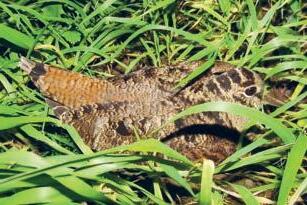
Reading the results of their studies I decided it would be good to get more people ringing Woodcock in the UK so that we could get a better picture of migration over more of their range. Up until this time almost all the Woodcock ringed in the UK were restricted
to study sites in Hampshire and Wiltshire where GWCT were conducting their research. In 2007, I was trained by Tony Cross, one of BTO’s most avid ringers, who had already been using dazzling to catch Lapwing, Golden Plover, Snipe and some Woodcock on pastures at night in West Wales. In 2008, Tony, a number of Woodcock enthusiasts from the shooting community and I set up The Woodcock Network with the goal of encouraging more people to ring Woodcock across the UK. This was done by writing articles, giving talks and offering advice on both equipment and technique to people contacting us through our website and via social media. Although progress was initially hampered by a lack of BTO Trainers who had a knowledge of dazzling, our success was marked by an increase from 77 Woodcock ringed in 2007 to over 1,900 in 2019; this increased activity is geographically spread from Scotland to the Channel Islands and Ireland.
WHAT THE DATA SHOW
Ringers love retraps as they reveal valuable information about site fidelity and, after a few years of ringing over 200 Woodcock each winter, my retrap data started revealing an impressive level of wintering site fidelity, which has since been confirmed by data from other Woodcock ringers across the country. Most of Wales has few or no breeding Woodcock, something which would distort any picture of wintering site fidelity. Of all the adults I catch each year, an average of 46% of them were birds I had ringed in previous winters. It was notable that birds were often recaptured a few metres, or sometimes less, from where they were first caught and ringed. This high level of wintering site fidelity is now a major part of the presentation I give to shoots when I give talks on Woodcock. My message about their Woodcock being faithful to their woods and fields has increased awareness that shooting them in big numbers will have an adverse impact on local abundance. It is gratifying to hear many shooters saying they no longer shoot Woodcock and many shoots now forbid it. Having a foot in both camps has its advantages – despite being uncomfortable at times!
Autumn 2022 36 — LIFECYCLE MONITORING | Woodcock
Woodcock, by Owen Williams/BTO
In 2010, the whole of the UK experienced particularly cold and snowy weather in December. Although ringers are advised to cease ringing during such conditions, I contacted BTO to request dispensation so that we could gather weight data to see how Woodcock were coping with the cold weather. These data added significantly to a paper published in the Journal of Applied Ecology titled ‘Regulation of body reserves in a hunted wader: Implications for cold-weather shooting restrictions’ (Sánchez-García et al. 2018). Analysis showed that Woodcock fare worse than previously thought in cold weather and therefore it is a mistake for the species to be treated the same as wildfowl with regard to voluntary and statutory severe-weather shooting suspension. The message regarding greater restraint has been publicised by me and GWCT since we published the paper.
TAGGING STUDIES
Tagging using satellite tags, geolocators and GPS loggers has been a major part of recent GWCT studies on Woodcock and I have fitted most of the tags on Woodcock in Wales since 2012. Though the information gained from tagging is currently being analysed, preliminary findings have revealed some fascinating detail regarding migration strategies. Ringing data have shown us that juveniles arrive in the UK in the autumn around three weeks earlier than adults: this may be due to adults needing to recover from their post-breeding moult before storing enough energy reserves for migration. We have also observed from tag data that adults appear to vary their migration strategy according to weather conditions on the Continent. Birds that have been tagged in the UK don’t always return to the UK in following years, with some stopping their migration if conditions
appear to be suitable along the route. This is also possibly the reason that my adult retrap figures over the past 10 years, although averaging 46%, vary between 29% and 75%.
DAZZLING
Over recent years many ringers have turned their hand to dazzling Woodcock along with other species in the winter when weather conditions make mist netting difficult. Recent developments in battery and lamp technology have brought the benefit of much lighter equipment; many ringers now use Li-ion-powered LED lamps and thermal scopes have also made locating birds in the dark much easier.
Having refined my technique over the years, I still prefer the lamp and have learned that eye shine is the best way of locating birds at considerable distance. Many people make the mistake of holding the lamp too low and are not picking up eye shine, which you only get if you are looking as closely down the beam as possible. The final few yards before netting requires stealth, particularly in calm conditions when sound is not carried away on the wind. For that reason, approaching into the wind works best, but I have found that in strong wind it is easier to approach downwind as noise is less of an issue and handling the net against a strong wind gets difficult.
Although uncomfortable, catching in damp, windy conditions is easier; however in these conditions I always carry a towelling facecloth to wrap the bird in as this mops up any moisture on the plumage. Beginners often rush the final netting with a swish of the net, frequently causing the bird to escape, particularly if the net is held too high above the bird before lowering it. I find that dropping the net steadily from a horizontal position works best.
AGEING WOODCOCK
I am frequently asked for tips on ageing Woodcock and there is a comprehensive guide on The Woodcock Network website, however the basics are:

- Juveniles show wear on the tips of the outer primaries (P10, P9, P8) whereas adults have new feathers moulted after breeding so tend to look less worn with neater terminal bands
- Adult upper primary coverts have a pale terminal band, whereas in juveniles the colour tends to be similar to the background cinnamon colour of the wing feathers.
- Adult greater underwing coverts have a flatter tip than on juveniles, which tend to appear more spear shaped.
- Overall adult wing plumage tends to show greater tonal variation between dark and light areas.
It is important to use all four age tests as each can be quite variable between individual birds.
LIFECYCLE — 37 Autumn 2022 Woodcock | MONITORING
Woodcock, by Owen Williams/BTO
Overall connectivity for Lesser Whitethroat and Common Whitethroat. Lesser Whitethroats mainly migrate south via the Middle East to wintering grounds in East Africa. In contrast, Common Whitethroats move south on a broad front to winter in Africa, just south of the Sahel. For both species, African recoveries are scarce, emphasising the need for additional tracking studies.
Eurasian African Bird Migration Atlas
Earlier this year saw the publication of the online Eurasian African Migration Atlas. The Atlas documents the migration and movements of 300 species based on ring recoveries from the EURING databank and, for around 100 species, also tracking data from Movebank. In this article, Stephen Baillie and Sam Franks present the key features of the Atlas.
View the Atlas online at: https://migrationatlas. org
A list of national migration atlases can be found at: https:// euring.org/research/ migration-atlases
Please see: https:// migrationatlas. org/contributors for full details of contributors including host organisations, steering committee members, the project team members, and for links to pages on the contributing Ringing Schemes.
Twenty years ago the publication of the British and Irish Migration Atlas represented a landmark achievement for the BTO Ringing Scheme, drawing together what we had learnt about migration and movements from ringing birds over almost 100 years. Since then many other national migration atlases have been published for individual European countries, but there was an urgent conservation and scientific need to provide a continental and flyway-scale synthesis of this information.
The wealth of information on connectivity that is now available is well illustrated by the Common Starling, for which we can see clear differences in the movement patterns of different European populations (Map 1). We can also make fascinating comparisons between the movements of closely related species such as Whitethroats and Lesser Whitethroats (see header image). Tracking data provide much valuable additional information on particular populations, and bringing ringing and tracking data together often provides the best available information on movement patterns (Map 2).
The online maps and tables provide a wealth of information on movement patterns, with many options allowing the presentation to be adjusted by the user, for example by selecting only particular subcategories of data. In addition to the overall connectivity maps you can view connectivity by age, sex and cause of recovery. The latter option is particularly helpful for checking whether particular recovery causes, such as hunting or recaptures by ringers, are influencing the overall patterns. For each of our main focal regions you can plot a map where recoveries are colour coded by month, and there are also animated maps of seasonal movements by 10-day periods. The maps are supported by a range of graphs and tables summarising many aspects of the data, including recovery categories, distances moved, the regional distribution of data and temporal trends in data availability. Species texts, written by an international team of experts, are closely linked to the different map types and include supporting references.
In addition to the online maps and species accounts, which were themselves a huge undertaking, the Atlas also includes

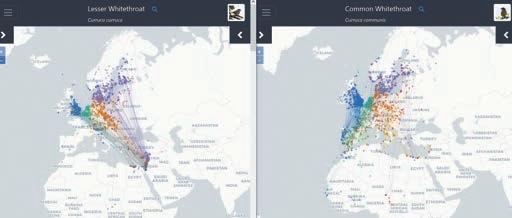
Autumn 2022 38 — LIFECYCLE EURING | European Migration Atlas
four research modules. An analysis of historical changes in migration patterns evaluates the evidence for changes in migration patterns over time, and how these may be influenced by factors such as climate change. Work on intentional killing of birds by man looks at long-term changes in patterns of killing, particularly illegal killing and other activities that fall outside well-managed and sustainable hunting systems. Information derived from reported causes of recovery provides many unique insights in this area. An analysis of the migration seasons of hunted species focuses on more formally managed quarry systems, using ring-recovery data to define spring migration seasons within which the EU Birds Directive does not allow hunting. Finally, a large-scale analysis of migratory connectivity provides a novel analysis of how populations of a wide range of species within the European–African migration system are linked. Each of these research modules includes a detailed report that can be downloaded from the Migration Atlas website. There is also an Executive Summary, also downloadable from the website, that provides an overview of the project and a synthesis of the main conservation conclusions.
THANKS
The Atlas has been produced by EURING, working in close collaboration with Movebank, whose users provided the tracking data. We are extremely grateful to the Italian Government who funded the project and to the Convention on Migratory Species and the Institute of Avian Research, Germany, for organisational support.
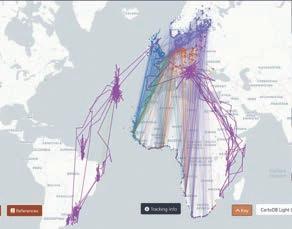
The Atlas is the product of work by a large international team coordinated by the EURING Atlas Management group: Stephen Baillie (Chair), Wolfgang Fiedler (Secretary), Franz Bairlein, Fernando Spina and Kasper Thorup. Particular thanks to our colleagues in the BTO IS Team who built the amazing website and to Jacquie Clark as volunteer editor of the species accounts. However, the biggest thanks are due to ringers past and present from the BTO scheme and across Europe. Without your amazing fieldwork efforts this Atlas would not have been possible.
Map 1: Overall connectivity of Common Starlings. Populations from northern and eastern Europe move south to winter in western Europe, including Britain and Ireland, while British and Irish breeding populations are largely resident. Birds breeding in central Europe move southwest to winter in southwest Europe and North Africa.
Map 2: Overall connectivity for Common Terns based on both ringing and tracking data. Recoveries show that Common Terns breeding in Britain and Ireland winter mainly off the coast of West Africa, while birds from northern Europe have a higher proportion wintering off South Africa. Wintering grounds of birds from central Europe are intermediate. Geolocator tracks confirm limited recovery evidence that birds from the Azores winter in South America while those from Croatia and Hungary winter along the coast of East Africa.

LIFECYCLE — 39 Autumn 2022 European Migration Atlas | EURING
Moult, WILWAs and climate change
Combining nesting and ringing records with climate data, Research Ecologist Hugh Hanmer and Ecological Statistician Philipp Boersch-Supan look at how investigating phenology across the annual cycle may help us better understand the diverging population trends of Willow Warbler in Britain.
Heating of the climate is changing the timing of biological events (phenology), such as migration and breeding in birds and other taxa. The consequences of such changes have been well studied in the context of food webs, for example by looking at the impact of mismatches between the timing of peak prey abundance and when food requirements of predators are greatest, such as when feeding their chicks. Phenological changes can, however, create other challenges. If the timing of key lifecycle phases, like breeding and moult, changes at different rates relative to each other (known as differential shift), their schedules may come into conflict, and compromise an individual’s ability to breed or survive successfully, potentially leading to negative population impacts. Alternatively, differential phenological shifts may reflect underlying changes in species population dynamics such as breeding success.
If the phenology of moult and breeding shift differentially under
the same environmental conditions, energetic demand on birds could be relaxed or exacerbated, and productivity or survival could be impacted. For example, if the timing of breeding advances more, the breeding season could lengthen, with potential benefits to productivity, while a greater advance in moult phenology relative to egg laying could reduce productivity by shortening the potential breeding window; however, cause and effect can be difficult to untangle. Breeding failure can also trigger an individual to moult early, so regional variation in differential phenological shifts could just reflect differing patterns of warming between regions. A better understanding of the changes to breeding and moult phenology can help us understand the current and future implications of climate change on bird populations across their ranges.
WILLOW WARBLERS AND CLIMATE CHANGE
Willow Warblers are a good species to begin studying differential phenological shifts in breeding and
moult because they are a widespread species that is ringed in good numbers and, although populations are declining overall, shows regional trend variation: within Britain, southern populations are declining while northern ones are increasing (Morrison et al. 2016). They are also typically single brooded (aside from replacement clutches) reducing the complication of multiple broods when examining breeding timing. Climate change has been identified as a potential driver of their population decline, most likely by affecting breeding success.

ESTIMATING PHENOLOGY
Our study was based on British records spanning 2000–18. We used NRS data to estimate first-egg dates and female breeding condition (brood patch scores) to estimate the end date of incubation (or brood patch regression, that is when brood patch scores of 4 and 5 start being recorded). Lastly, we analysed adult moult records (from birds with either Old, active Main (with primary scores) or New moult scores)
Autumn 2022 40 — LIFECYCLE RESEARCH | Willow Warbler moult
Moult is an often underappreciated and under-recorded lifecycle phase in birds, even though it is an energetically costly process influenced by many of the same factors that determine the timing of breeding, such as photoperiod and temperature.
Willow Warbler in moult, by Justin Walker/BTO
to estimate the start and duration of primary moult. We looked at how the phenology of each lifecycle phase changed with site latitude and spring temperature anomalies, i.e. whether sites were warmer or cooler in a year than the average at that site, as a measure of climate warming.

We found that birds in the south moulted both earlier and faster in warm springs compared to cooler springs and more northerly latitudes, whereas the relationship between first-egg date and local spring temperature remained much the same across all latitudes. Differences in the timing of broodpatch regression and therefore the end of incubation were more complex. Regression occurred earlier in warmer springs, with the effect of warming being most marked in the north. However, overall levels of brood-patch regression were higher in the south early in the breeding season, when they most likely reflected brood losses rather than completion of early successful broods.
Towards the end of the breeding season, the effect of temperature on brood-patch regression was reversed, indicating an overall later completion of the incubation stage in cooler springs, despite proportionally little change in first-egg dates, so indicating a longer breeding period, likely as a result of incubating replacement broods. This is reflected in the regional differences in population trends, with those in northern Britain (Scotland) increasing by 25% while those in the south (England) decreasing by 45% (BTO BirdTrends).
Our findings indicate that the earlier start to the breeding season has reduced potential moult–breeding conflict in northern populations, but similar shifts in the south to earlier breeding initiation have not resulted in the same positive effect on population trends there. This appears to be because warming is also associated with a higher proportion of early southern nest failures, and subsequently earlier moult.
In line with previous experiments, which have shown that moult is
triggered earlier in warmer conditions, our own findings suggest that the likelihood of earlier brood-patch regression increases in warmer springs. Given observed population and demographic trends, these effects may act together to produce the observed regional differential shift in moult phenology, and thus the declines may become even more pronounced as our climate continues to warm. This is especially important given we find evidence that warmer northern springs shift brood-patch regression even earlier, suggesting recent northern population gains could be reversed under further warming if it results in higher rates of brood failure.
We also found that, parallel to an advancing moult start, moult duration is shortening with increasing spring temperatures in the south, but not the north. This could be advantageous for southern birds by reducing the period when moulting birds are flight-impaired, or it could be a problem if faster-grown feathers are of lower quality. As regional differences in adult Willow Warbler survival have not been identified, it seems the impact of this change in moult duration is limited so far. This could be related to Willow Warbler’s biannual moult replacing feathers earlier and faster than in most passerines, mitigating any
potential effects which could impact species with different moult strategies.
By pinpointing challenges within the annual cycle, your data are shedding light on why we see different regional population trajectories in this species; it also emphasises the value of additional data gathered during ringing. So, if you don’t already do so, please consider recording moult and breeding condition (and, importantly, their absence, i.e. moult codes O/N and brood patch score 0), wherever practical. Such biometric data allow us to add important biological context to the survival and migration estimates derived from ring recoveries, and inform further research on the state and fate of our birds.
REFERENCES
Hanmer, H.J. et al. (2022) Differential changes in life cycle-event phenology provide a window into regional population declines. Biology Letters 18, 20220186, doi:org/10.1098/rsbl.2022.0186
Morrison, C.A. et al. (2016) Demographic drivers of decline and recovery in an Afro-Palaearctic migratory bird population. Proceedings of the Royal Society B Biological Sciences 283, 1842.
Willow Warbler predicted breeding and moult phenology with respect to spring temperature anomaly and degrees north latitude. Plotted with 95% confidence intervals, which tend to be wider at the extremes (i.e. in this case the coldest and warmest springs) due to reduced samples to draw on.
LIFECYCLE — 41 Autumn 2022 Willow Warbler moult | RESEARCH
Developing the Nest Record Scheme
The Nest Record Scheme (NRS) contributes a wealth of information to our understanding of how successfully birds are breeding on an annual basis. Although we receive around 40,000 nest records per year, more are needed to increase the accuracy of the trends produced and enable reporting at a finer scale. In this article, Lee Barber provides an update on recent NRS developments aimed at increasing the number of nest recorders and making it easier for new nesters to join the Scheme.
Following updates and development of both the BTO membership and NRS databases, we have been able to provide online signup to NRS for the first time. This should make it easier and quicker for new participants to take part in the Scheme and reduce the need for staff involvement in the process. To date, we have received 286 new participants to the Scheme this year, the largest recruitment in recent history, beating the previous peak when NRS featured on SpringWatch in 2013, resulting in 230 new nest recorders.
This increase in the number of new nest recorders is not all down to online signup though. This year we also have increased the profile of NRS on social media and in magazines such as BirdWatch and other BTO publications. In addition, existing nest recorders have been spreading the word about NRS by running various nest recording ‘taster days’ in England, Wales and Northern Ireland.
One of the biggest challenges new nest recorders face is learning how to find nests to monitor. To help with this, we have a network of NRS Mentors who are willing to provide support and advice to new and existing nest recorders. As part of the recruitment
push, the mentoring section of the NRS website has been redeveloped to incorporate an interactive map of Nest Record Mentors. Each pin on the map shows the location of a Mentor and the type of guidance they can offer. The knowledge offered by these 95 Mentors shouldn’t be underestimated and we encourage anyone who is interested in developing their nest-recording skills to contact their nearest Mentor to discuss ways they can help or to ask those burning nest-finding questions.
Most Mentors have their own areas of interest, including which species they monitor or geographical areas that they focus on. We would like to offer our huge thanks to the Mentors who are supporting this initiative. It is hoped that more nest recorders will become Mentors in the future, so if there isn’t anyone in your county (or even if there is) and you feel able to, please consider signing up.
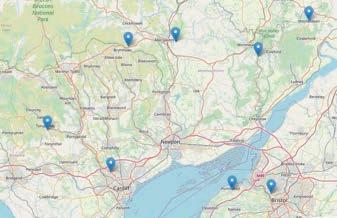
The rest of the NRS website has also had a restructure, focusing on three main areas: ‘Taking part’, ‘Developing skills’ and ‘Results and publications’. We hope these pages will cover the majority of questions new and existing nest recorders will have around how to record a nest, the Code of Conduct,
DemOn, mentoring, courses and the latest results. There are more web developments to come in due course.
To help keep nest recording in mind throughout the breeding season, a specific NRS electronic newsletter was launched last March with content including what is currently nesting, techniques used to find and record nests, as well as updates from guest nesters. The feedback from this newsletter has been positive and it will continue in future throughout the main breeding season. If anyone has something they would like to see included please contact nrs@bto.org
Nest Recording isn’t just about the quantity of records received, but the quality. Recording the timing of breeding and the number of eggs or chicks in a brood can help pinpoint the causes of population change, so nest records which include information gathered during several visits are particularly informative. In addition, information gathered from subsequent records of ringed pulli can improve our knowledge of dispersal and survival.
Autumn 2022 42 — LIFECYCLE
FIELDWORK | Nest Record Scheme
The Nest Record Mentor map can be accessed when logged into My BTO.
Obituaries
summer he had been involved in a pilot study of ringing at Wicken Fen which led to the formation of the Wicken Fen Group in early 1969.
The BTO, and the Ringing Scheme in particular, have lost a great contributor with the sudden death of Michael Holdsworth in early September 2021 whilst on a walking holiday in the French Alps with his wife, Sue.

I (PB) first met Michael in the autumn of 1969 when he was an undergraduate. He organised a series of visits to some local glasshouses containing dead tomato plants where Pied Wagtails came in to roost through the open windows. We picked them from the plants, bagged them and took them back to Michael’s flat in Chesterton for processing, releasing them at first light. The previous
Michael learned to ring at his school in the grey granite town of Sedbergh. His last session was at Chippenham Fen a couple of weeks before he died, so he was ringing for nigh on sixty years. Michael made a significant contribution to the Wicken Fen Group over many years, particularly at the vitally important reedbed area, where he also ran a CES from 2013. Always willing to do the hard yards in terms of setting up nets and maintaining the rides, he encouraged volunteers with ‘you can arrive late or leave early, but not both’!
He was always interested in the small, brown inhabitants of reedbeds. His summers were also dominated by his passion for another small and unobtrusive bird, the Spotted Flycatcher. Michael worked alongside the BTO to discover where these birds wintered and investigate the timing of their migration and the route they
of 1965 at Hay in Brecknockshire. Following a short academic stay in Australia, they returned to Fife, James becoming senior lecturer in Zoology at St Andrews and settling at Kingsbarns.
took outside the breeding season. He enjoyed building lasting relationships with the owners of the Cambridgeshire gardens through frequent updates of the project’s progress.
Michael cared deeply about the birds of Cambridgeshire and was on the Council of the Cambridgeshire Bird Club as Secretary and Ringing Secretary, bringing his enthusiasm, knowledge and expertise to the group. He used both his professional publishing experience at Cambridge University Press and his wry humour to produce informative and interesting articles, including the Bird Ringing Report, for the Annual Report. Michael also made a considerable contribution to the Cambridgeshire Bird Atlas 2007–2011 and promoted the Club to fellow birders and ringers.
Michael’s death leaves a huge hole, impossible to fill in so many ways. Personally, we are left shocked since he seemed such a robust and fit man.
This obituary was prepared by Peter Bircham and Carole Davis
Dr James (Jim) Cobb, passed peacefully on 15 August 2021 at Ninewells Hospital, Dundee, after a long illness. James is survived by his wife Calla, daughters Emily, Caroline and Victoria and grandchildren.

James was born on 27 August 1941 at Cuckfield, Sussex, a family move taking him to Brecon at a young age. There he learnt to ring birds, gaining his A permit at age 14.
He attended St Andrews University, going on to gain a PhD there. He and Caroline (Calla) married in the summer
Bird ringing remained a passion. Upon returning to Fife, he realised the potential of Fife Ness for migratory birds. So began the transformation of a rough stony patch area into Fife Ness Muir, the ‘Patch’. Expert advice, salt spray and rough ground said the site was not suitable for planting; he proved otherwise.
Enlisting the help of Calla and the children, he planted up the Patch with thousands of trees over the years. Later, fearful for the site’s future, James purchased it and placed it under the auspices of the Scottish Wildlife Trust. He continued to manage the reserve as its convenor.
During migration periods, Jim would be present there every day,
welcoming birdwatchers and giving many their first experience of ringing. James reckoned, late in life, he had ringed over 150,000 birds of around 200 species – his ringing legacy though is greater than just numbers. He had an aptitude for teaching, was constantly active, passing skills, knowledge and inspiration to his many trainees who now ring in many parts of the world.
Aside from ringing, James was an accomplished gardener. He grew awardwinning vegetables and flowers and was a world authority on the Meconopsis poppies, authoring a book on the genus in 1989.
His life was celebrated by his family and his many friends at a service at Kingsbarns Parish Church on 30 August 2021.
This obituary was prepared by Mark Oksien, Tom Dougall and Alan Lauder
LIFECYCLE — 43 Autumn 2022 Obituaries | COMMUNITY
MICHAEL HOLDSWORTH 1948–2021
JAMES COBB 1941–2021
In 1963, as a young ringer, Robin was a founder member of the Chew Valley Ringing Station (CVRS) and played a central role within the organisation throughout his life.
When I emailed the membership to say that Robin had died, I received a flurry of replies, with everyone saying
how much he meant to us. What was most noticeable was the consistency of the sentiments for, without exception, all commented about how encouraging and helpful he had been to them personally and recounted fond memories and stories.
He will have been known to many ringers as one of the Trainers on every one of our summer courses since 1990 and also through his attendance at the ringers’ conferences. He was also a regular on the British Birds magazine stand at the annual British Birdwatching Fair, having been on the editorial panel for 33 years.
His involvement with birds and an appreciation of the natural world led to him joining the BBC Natural History Unit in 1968 where he worked as a producer until his retirement in 1991. Locally too he’ll be remembered for his active participation with the Bristol

Ornithological Club, including organising and leading many field trips at home and abroad.
His main study, that occupied him for over 40 years, was of the Buzzards that live in the area to the west of Bristol. From the hundreds of hours of fieldwork he knew many of the birds as individuals, plotting their territories and productivity as the population increased.
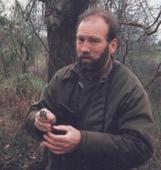
As an excellent artist he illustrated a number of bird reports, books and magazines. At Christmas time we looked forward to receiving his cards which featured one or two of ‘his birds’ and an accompanying anecdote about them.
So, thinking back, we can see that his was a full life, well lived and one that will be fondly remembered.
This obituary was prepared by Mike Bailey
Mike started ringing in 1959 at Dungeness Bird Observatory under the tutelage of Bert Axell. However, following the tragic death of his brother Steve, also a ringer and member of staff at BTO, he left the Scheme in 1968. Seven years later he re-registered following a short refresher course, and at the same time moved from Surrey to Nottinghamshire. He quickly established three regular ringing sites – one in north Notts and two at Theddlethorpe Dunes on the coast of Lincolnshire.
ringers who operated their sites in a similar, constant-effort way – John McMeeking (Treswell Wood, Notts) and Bob Spencer (Marsworth Reservoir, Hertfordshire). Thus, a pilot study involving the three sites became established in 1981. Mike delivered the results of the pilot to a packed audience at the Ringers’ Conference in January 1983 and, so convincing were the data, that BTO formally set up CES later that year and opened it up to all ringers interested in participating.
For a generation of ringers active in the mid 1970s to mid 1980s the name Mike Boddy will be a very familiar one. For later generations however, I suspect his name will mean little, and many won’t have heard of him at all! If you are such a ringer and run a Constant Effort Site then you might be interested to learn something of his backstory and the role he played in its development.
So regular was he to these sites that he came up with the idea that a constant-effort approach to ringing, i.e. using the same nets in the same locations over a given period, might be a way of estimating bird populations from one year to the next, in a way similar to that of the BTO’s Common Birds Census, but with the added bonus of including a suite of species not then covered by CBC.
To test this approach and widen his project he identified two other
Mike Boddy was an influencer and possessed dogged determination – in a nice way! He served on the Ringing Committee during 1979–86 and was awarded the Tucker Medal in 1986 and the Boddy and Sparrow Award (an award set up by BTO in memory of Steve Boddy and Jonathan Sparrow) in 1991 for services to the Trust, in recognition of his CES work. He retired from the Ringing Scheme in 1998.
This obituary was prepared by Jeff Baker and Adrian Blackburn
Autumn 2022 44 — LIFECYCLE COMMUNITY | Obituaries
MIKE BODDY 1939–2022
ROBIN PRYTHERCH 1940–2021
Uphill for Pied Flycatchers
It’s becoming harder to check my Pied Flycatcher nest boxes! The oak woods of Herefordshire, to which Pied Flycatchers and Redstarts return each spring, tend to be on steep slopes. This is land that is unsuitable for arable farming and would historically have been grazed and coppiced for timber production. As Dave Coker lugged himself uphill last spring, he reflected on the people who have checked nest boxes in the past – such as the inimitable Chris Mead – and wondered who might be counting and ringing chicks 20 years from now.
As ringers, we leave behind two legacies: the data we collect and the people we train. I am forever grateful to the late Mary Waller, whom I encountered when a friend took me to a meeting of Surbiton and District Bird Watching Society 50 years ago. When three of us expressed an interest in becoming trainees she took us on (when others would not), and the data we collected from an early Constant Effort Site near Surbiton are still appearing in analyses to this day. Mary introduced me to the Wash Wader Ringing Group, to Dungeness Bird Observatory, to Chris Mead and to BTO, which led to a cannonnet licence, years of committee work and 30 years of clambering up Herefordshire hills.
I have not made as much of a contribution as a Trainer as many others – I don’t do enough general ringing to be able to do so – but I am pleased to be able to introduce students to ringing and survey work, particularly through my contribution to the University of Worcester’s Conservation
Ecology course. It’s easy enough to talk about the work of BTO, which sets the gold standard when it comes to the collection, curation and analysis of survey and ringing data, and some of the students make good nest-box checkers.

Pied Flycatchers and the results of BTO analyses feature strongly in the presentation to the students which follows a demonstration of ringing. It is fascinating to consider how many people have contributed to the graph in the BirdTrends section of the BTO website, which shows that the average first-egg date for Pied Flycatcher is now 10 days earlier than it was in 1966.
Since 1980, 40 years of RAS studies have shown that annual survival rates of adults have remained stable (a rather boring graph, but in this case boring is probably good). Nest recording has revealed that chick losses have increased, potentially linked to a mismatch between the timing of peak caterpillar abundance and the requirements of hungry families. Last year seemed to have been a late spring, and my Pied
Flycatchers timed breeding well. What will others see in 2042?
I am still ringing and I hope I will continue to do so for a while yet. When I fall out of a tree – or off my perch – I shall be pleased to know that my data can be used in a ‘2043 paper’ about the changed fortunes of Pied Flycatchers, as they respond to climate change and biodiversity loss. Perhaps it might be written by someone whom I helped to inspire?
Looking forwards, I have pledged to leave a Gift to BTO in my Will. I want to support an organisation that has given so much to me personally and that I know will continue to work with ringers and surveyors studying Pied Flycatchers and other species in Herefordshire and beyond.
LEAVING A LEGACY
If you are considering leaving a Gift to the BTO in your Will, please contact sam.rider@bto.org who will be happy to help or visit our website www. bto.org/legacies and download our brochure.

LIFECYCLE — 45 Autumn 2022 Leaving a legacy | COMMUNITY
Dave undertaking a ringing demonstration for students.
Dave Coker ringing a Great Tit.
Photo courtesy of Dave Coker.
Using your data
This feature highlights some of the scientific papers that have been produced using the data that you collect through the Ringing Scheme or the Nest Record Scheme.

USING CES DATA TO HELP TARGET CONSERVATION ACTION
Many of the widespread and common species that are declining across much of Europe would benefit from targeted conservation actions. The abundance of declining species can be increased by boosting productivity or survival rates of adult birds. Conservation actions to boost these parameters can be designed, but they need to be targeted to places where either productivity or survival is consistently low and so can be improved. Using CES data from over 300 sites across Europe, researchers compared the extent of variation in survival and productivity between sites and years as well as the extent to which annual variation in these rates is synchronous across geographical space. For all 26 songbird species in the study, productivity on CES sites tends to be consistently high or consistently low across years. This suggests that local conditions on these sites are a major cause of the level of productivity. By contrast, survival rates of these species often vary more between years than between sites. Low survival rates are often associated with extreme weather, which is hard to predict. These results suggest that targeting actions to boost productivity would be the more effective use of funds and effort for migrating species as well as residents.
Morrison, C.A. et al. (2022) Demographic variation in space and time: implications for conservation targeting. Royal Society Open Science 9, doi: 10.1098/rsos.211671
EFFECTS OF WEARING GEOLOCATORS ON COMMON SANDPIPERS
As technological advances increase the variety of devices in the ringer’s toolbox, it is vitally important to keep testing and reporting their safety and efficacy for the birds being studied. These are studies where we hope for a null result, as that means the devices are having no effect on the birds or their behaviour. Geolocators have been around a while, but they are being used on more, and smaller, species to answer new or long-standing research questions, and so information on possible sideeffects is always valuable. Thomas Mondain-Monval and collaborators fitted geolocators to 32 Common Sandpipers and looked at the effect on the birds’ return rates, timing of arrival, body condition and breeding success. Comparing with a control group of untagged birds, the study found no effect for any of the variables tested; however, a few birds did incur injuries related to the dimensions of the geolocators, ranging from mild bruising and limping to loss of a leg. The authors stress the need for transparency in reporting these effects, so that methods can be refined for enhancing both welfare and data quality.
The rapid expansion of wind energy installations in the North Sea is vital for reducing Europe’s reliance on fossil fuels; however, the vast scale of the current and planned developments will inevitably have some effect on birds that use this area. Knowing how birds use the North Sea is therefore essential in understanding and mitigating these impacts. Ros Green and colleagues reviewed the evidence for how Shelducks move between Britain, Ireland and their moulting areas in the Wadden Sea, off the German and Dutch coast. The team used BTO ringing data and information from a pilot study using GPS tags to track the routes that Shelducks take to reach the moulting grounds. Birds from the entire British and Irish range had the potential to interact with wind farms in the North Sea when migrating, but ringing alone provided insufficient data on the routes taken. GPS tracking of four birds showed that they all left East Anglia in mid-July and completed the North Sea crossing in around 3–4 hours. Worryingly, the birds mostly flew at heights of below 150 m, putting them at risk of collision with wind turbines.
Mondain-Monval, T.O. et al. (2020) The effects of geolocators on return rates, condition, and breeding success in Common Sandpipers Actitis hypoleucos Bird Study 67, 217–223.

Green, R.M.W. et al. (2019) Migratory movements of British and Irish Common Shelduck Tadorna tadorna: a review of ringing data and a pilot tracking study to inform potential interactions with offshore wind farms in the North Sea. Ringing & Migration 34, 71–83.

Autumn 2022 46 — LIFECYCLE PUBLICATIONS | Scientific outcomes from the data you collect
SHELDUCKS AND OFFSHORE WIND FARMS
House Sparrow, by John Harding/BTO, Common Sandpiper, by Philip Croft/BTO; Shelduck, by Edmund Fellowes/BTO
Noticeboard
RINGING COMMITTEE 2022
RIN supervises the operation and development of the Ringing & Nest Record Schemes. RIN meets twice a year, usually in spring and autumn. Agendas, non-confidential papers, minutes and members’ contact details are available on the ringers-only pages of the website (www.bto.org/ringing-committee). Members are happy to receive correspondence throughout the year, either directly or via rin@bto.org
COMMITTEE MEMBERS
Lucy Wright – Chair – Cambridgeshire
Sam Bayley – Cork
Louise Clewley – Lancashire
Richard du Feu – Lancashire
Peter Kirmond – Gloucestershire
Jim Lennon – Nottinghamshire
Stephen Vickers – Norfolk
Roger Walsh – Norfolk
Alex Phillips – C-permit rep – Derbys
Hayley Land – T-permit rep – N. Yorks
POTTER TRAPS FOR SALE
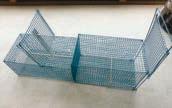
Two sizes (12” & 16”) also Chardonneret and other traps on request. Please contact John Mawer on 01652 628583 or via email johnrmawer@hotmail.com
RINGING OPPORTUNITIES
South Africa
Bird ringing contributes much to the fundamental knowledge needed for species conservation, including survival and movement information. Some of the most valuable data have been collected by long-term studies at ringing centres, where the ringing of birds by citizen scientists has taken place consistently for a long time.
The Biodiversity and Development Institute (https://thebdi.org) has set up a bird ringing centre in the Khoisan Karoo Conservancy (https://www.khoisankaroo.co.za/) We have two focusses: training bird ringers and building a long-term database. All BTO ringers and trainees are invited to join us.
The ringing centre is based at the New Holme Nature Farm, on the national road (N1) between Cape Town and Johannesburg. New Holme has excellent accommodation, outstanding food, awesome birding and amazing ‘Shy Five night drives’; we routinely see some of Africa’s trickiest mammals, such as Aardvark and Aardwolf.
A set of dates for upcoming events is on the website (https://thebdi.org and click ‘Events’), but feel free to contact us if you, or your ringing group, would like to come on alternative dates. The person to email is Dr Megan Loftie-Eaton (megan@thebdi. org).
WINTER RINGING VISIT PERIODS
CONTACTS
Nest Record Scheme: nrs@bto.org
Ringing Scheme: ringing@bto.org
Constant Effort Sites: ces@bto.org
Retrapping Adults for Survival: ras@bto.org
Colour ringing: colour.ringing@bto.org
Ringing data submissions: ringing.data@bto.org
Licensing: ringing.licensing@bto.org
Schedule 1: ringing.schedule1@bto.org
Ringing sales: sales@bto.org
THE 2023 CES VISIT PERIODS
LIFECYCLE — 47 Autumn 2022 Adverts, courses and conferences | NOTICES
Visit First Date Last Date No of Days 1 Sunday 30 April to Wednesday 10 May 11 2 Thursday 11 May to Saturday 20 May 10 3 Sunday 21 May to Wednesday 31 May 11 4 Thursday 1 June to Saturday 10 June 10 5 Sunday 11 June to Wednesday 21 June 11 6 Thursday 22 June to Saturday 1 July 10 7 Sunday 2 July to Wednesday 12 July 11 8 Thursday 13 July to Saturday 22 July 10 9 Sunday 23 July to Wednesday 2 August 11 10 Thursday 3 August to Saturday 12 August 10 11 Sunday
August to Wednesday 23 August
12 Thursday
August to Saturday 2 September
13
11
24
10
Visit Dates Visit Dates 1 5 Nov – 18 Nov 5 31 Dec – 13 Jan 2 19 Nov – 2 Dec 6 14 Jan – 27 Jan 3 3 Dec – 16 Dec 7 28 Jan – 10 Feb 4 17 Dec – 30 Dec 8 11 Feb – 24 Feb
Monitoring priorities: Dipper
Their remarkable underwater feeding habits make Dippers a charismatic sepcies to watch. Found in fast-flowing rivers, mainly in upland areas, they are Amber listed in the Birds of Conservation Concern report. Find out what you can do to help monitor this species.

CURRENT KNOWLEDGE
Dippers are currently Amber listed in the UK and have been showing significant national declines in their breeding population in recent years, according to WBS/WBBS data. Over this period, however, breeding success has improved and brood size has increased, suggesting that breeding performance may not be driving the overall population decline. There is some evidence to suggest that the decline may be driven by harsh weather conditions over the winter causing an increase in adult mortality, but more data on adult survival are needed to confirm this.
HOW CAN YOU HELP? Start a RAS project
There are currently six active Dipper RAS projects and, while the survival
trends for this species is classified as of ‘Good’ quality, more projects will help us understand better why it is declining. Dippers are an ideal RAS species as they return to the same territory to breed year on year and spend much of their time perched along rivers, providing ample time for reading colour rings in predictable locations. Fortunately, resighting and capture of adults can remain productive into the winter as many Dippers hold their territories year-round, especially those breeding in high-quality habitat and where extremes in water flow like flooding or freezing are not as pronounced. As with many species, juvenile mortality is relatively high in the first few months post fledging and young birds may disperse quite far from their natal area. Because of this, colour ringing of juvenile birds pre-dispersal can lead to many wasted
colour-ring combinations, so it is best to focus on colour ringing adult birds until the winter period.
Install a nest box
Dippers tend to nest in either natural locations in riverbanks or under artificial structures that cross or are adjacent to rivers, such as bridges, and they take well to nest boxes installed on bridges. As Dippers can struggle to make nests on some modern structures, such as bridges with smooth walls, installing nest boxes can facilitate Dipper breeding; these nest boxes are then perfect for nest monitoring. More nest records of Dippers from Scotland would be particularly welcome.
An article in the Spring 2016 edition of LifeCycle is a good starting point for those wanting to learn more about monitoring Dippers.
taken from the BirdTrends report (www.bto.org/birdtrends), where results from the Ringing Scheme and Nest Record
Graphs
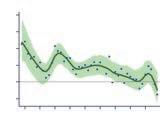

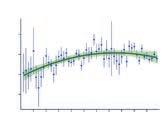 shown are
Scheme are published annually, alongside census data.
shown are
Scheme are published annually, alongside census data.
0.0 0.2 0.4 0.6 0.8 1.0 1975 1980 1985 1995 1990 2000 2010 2005 2015 180 160 140 120 100 80 WBS/WBBS index UK 1974–2019 1970 1975 1980 1985 1990 1995 2000 2005 2010 2015 Fledglings per breeding attempt RAS Survival 2002–18 2005 2015 2010 3 4 2 1
Dipper, by Ruth Walker








































































 shown are
Scheme are published annually, alongside census data.
shown are
Scheme are published annually, alongside census data.